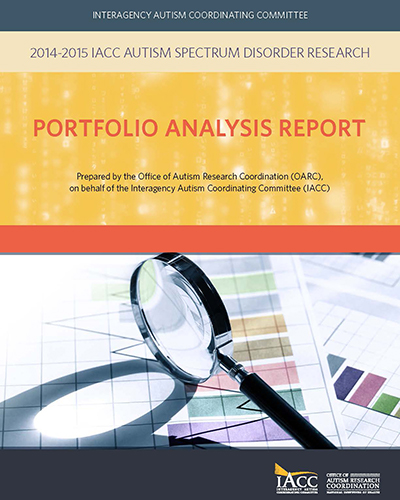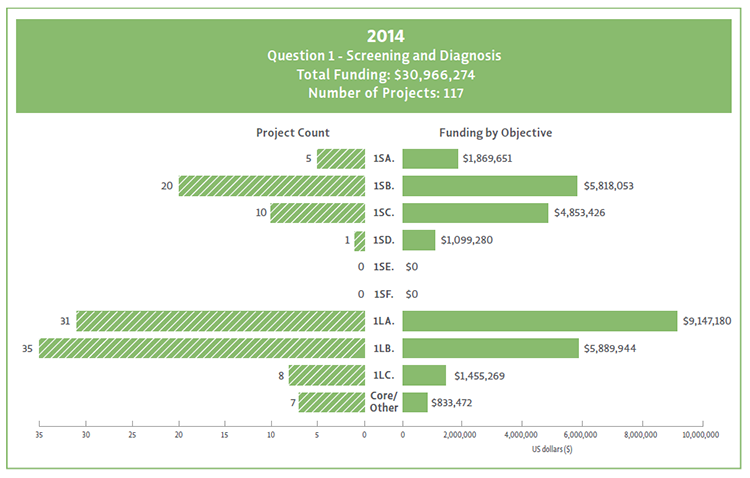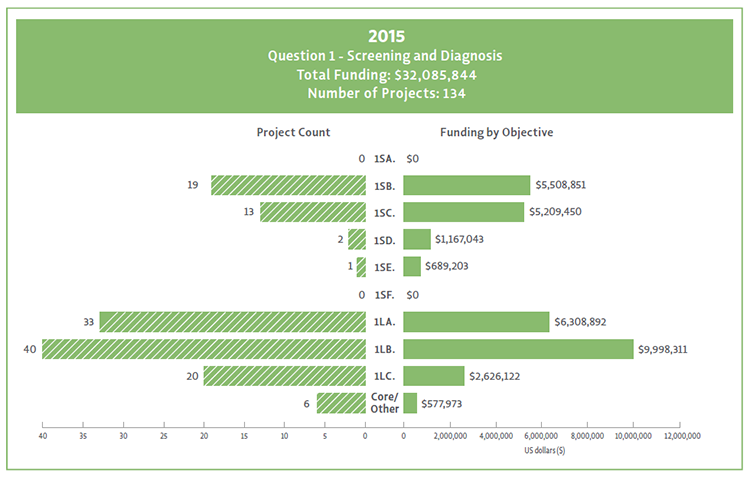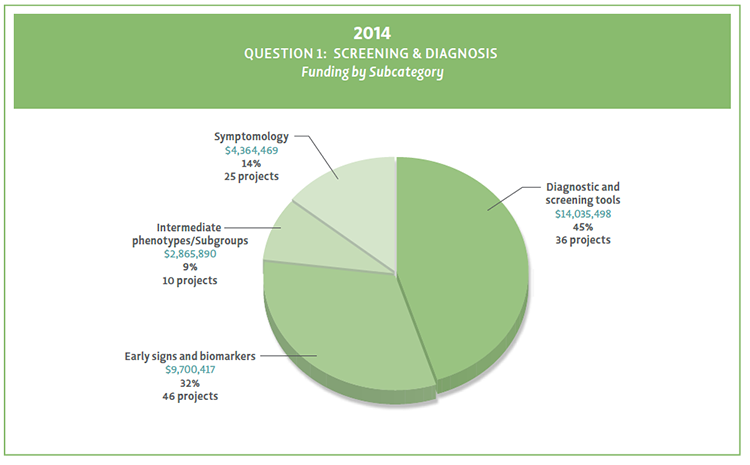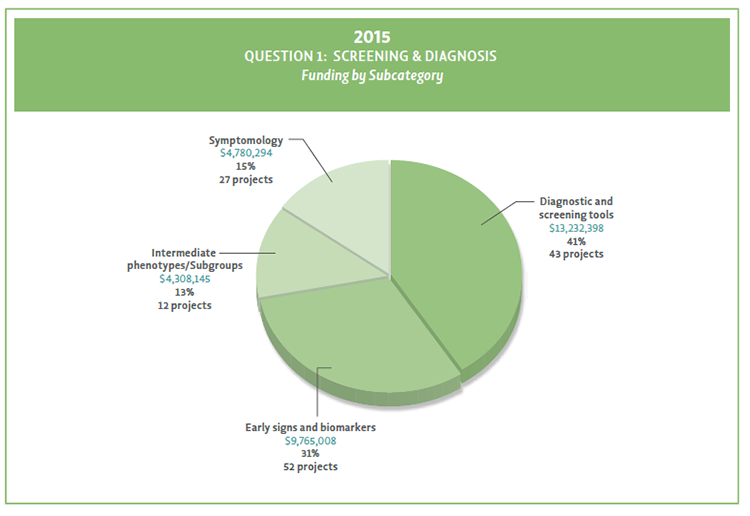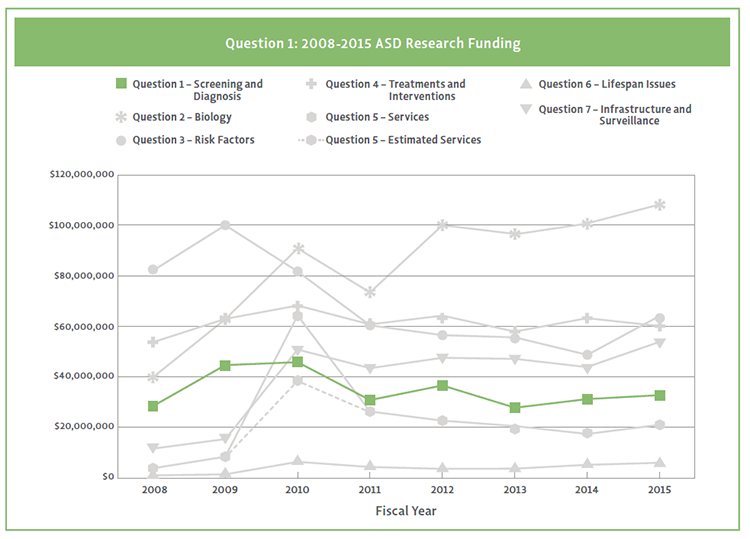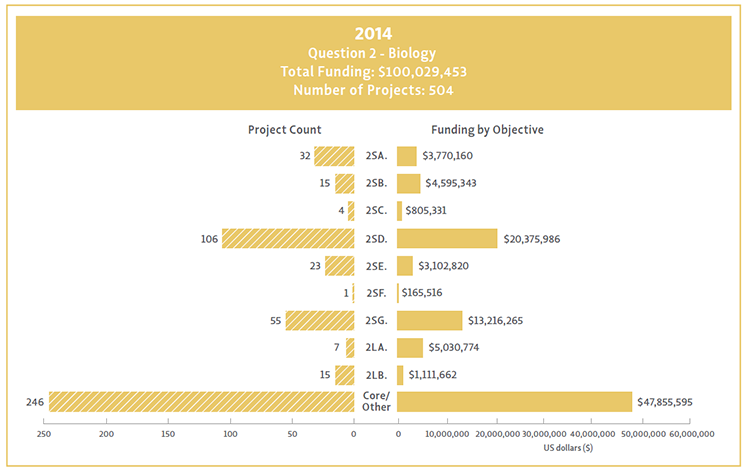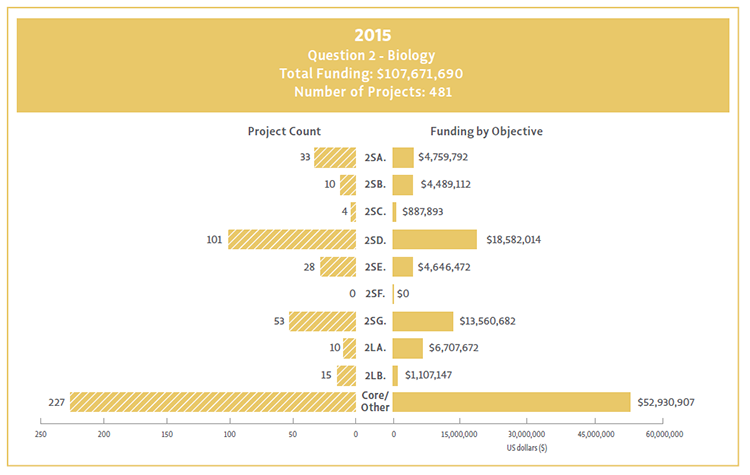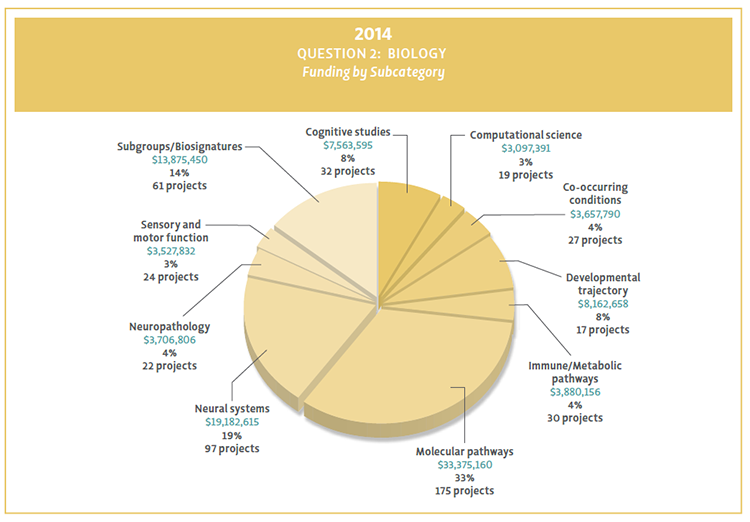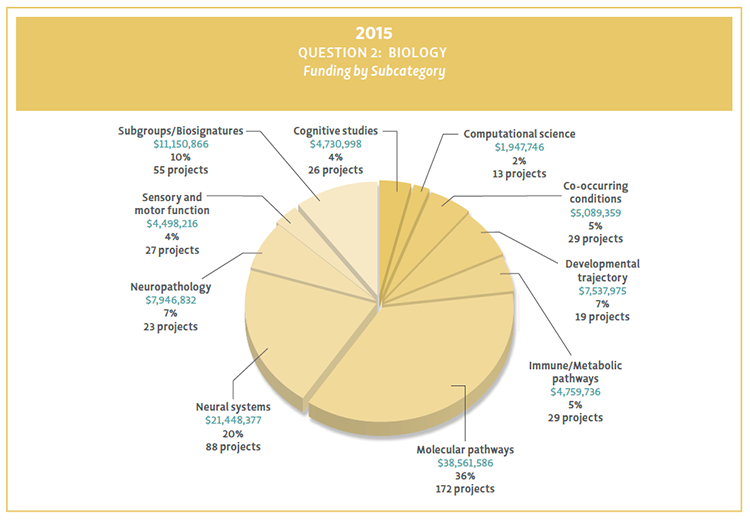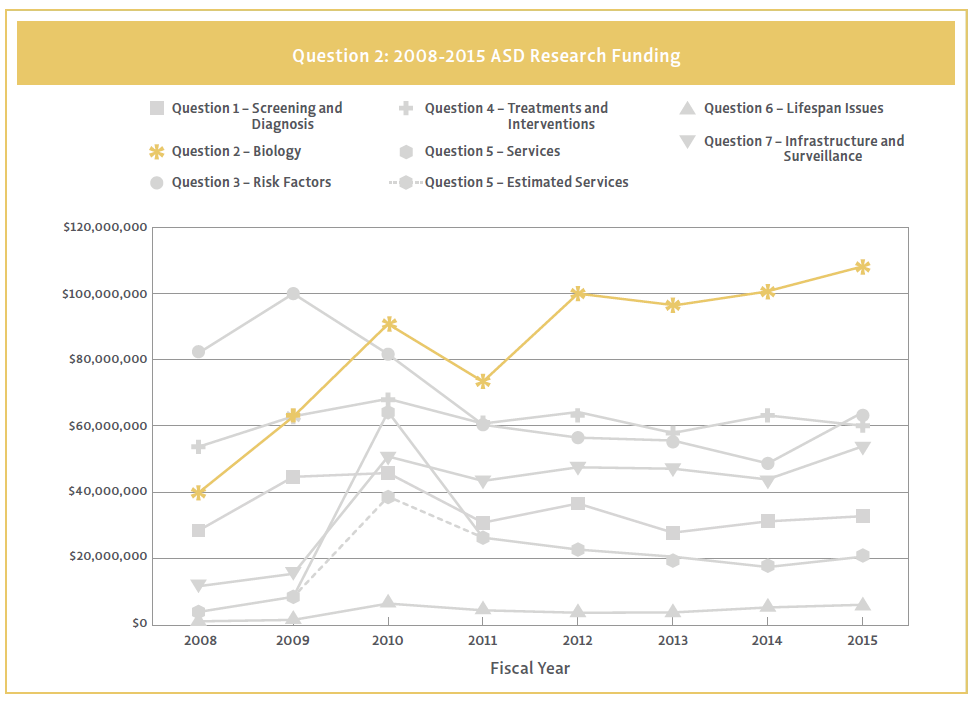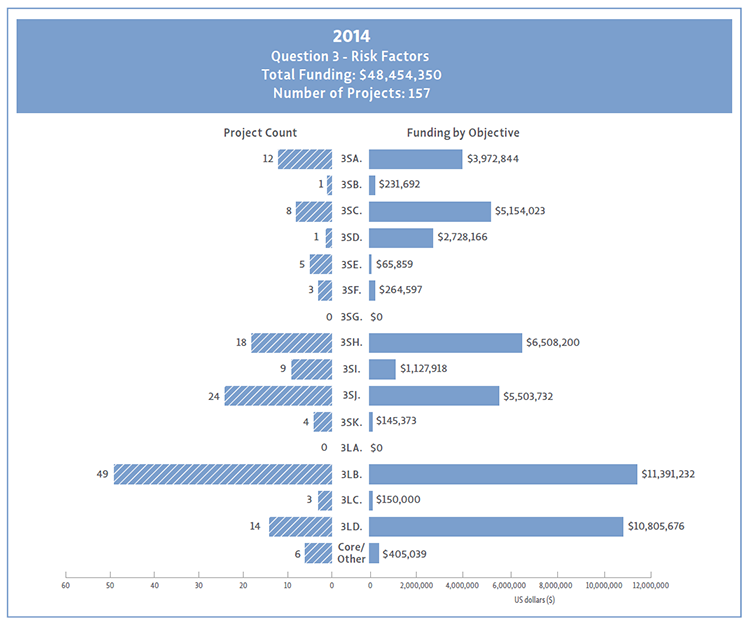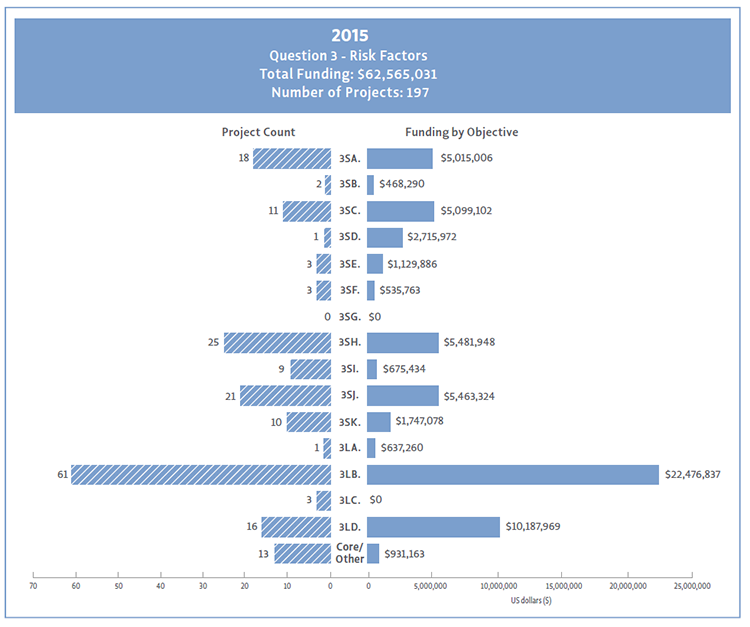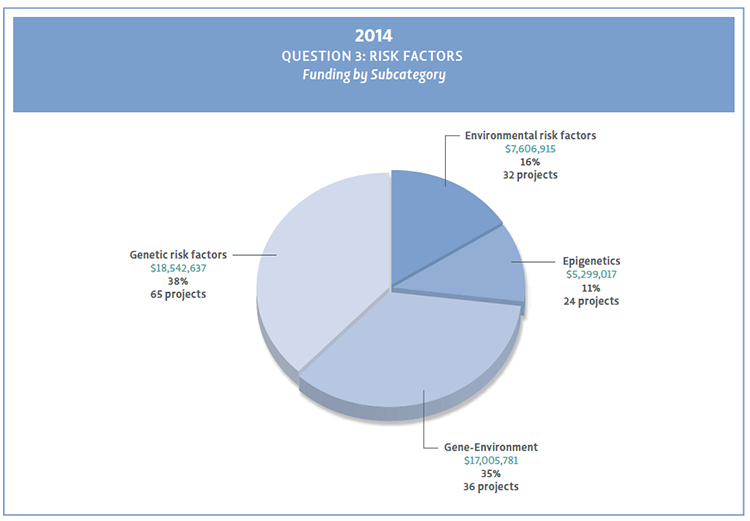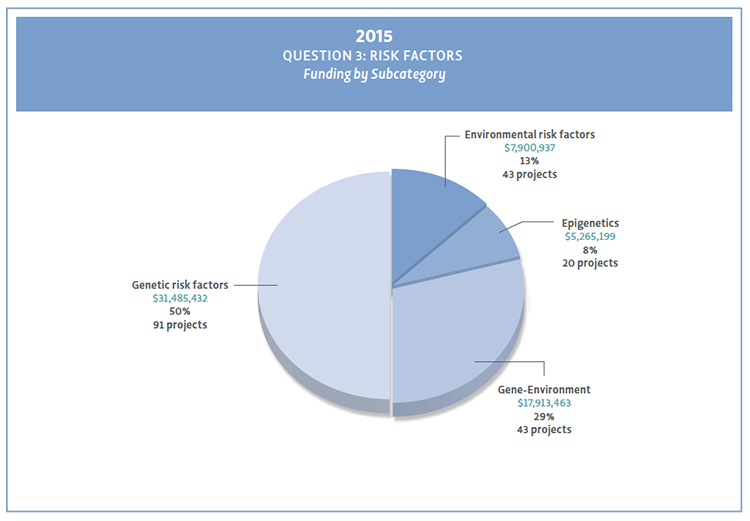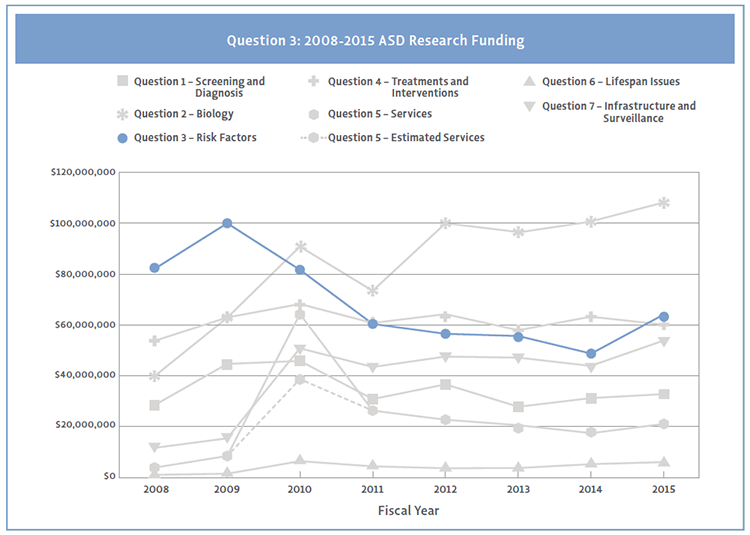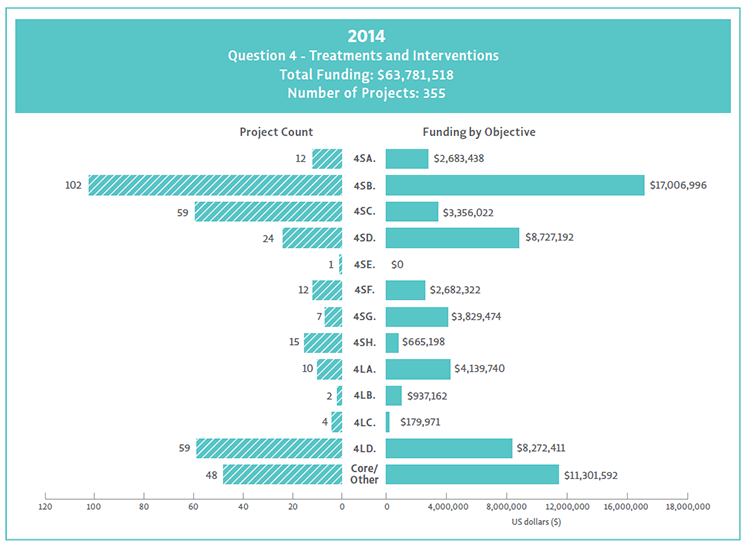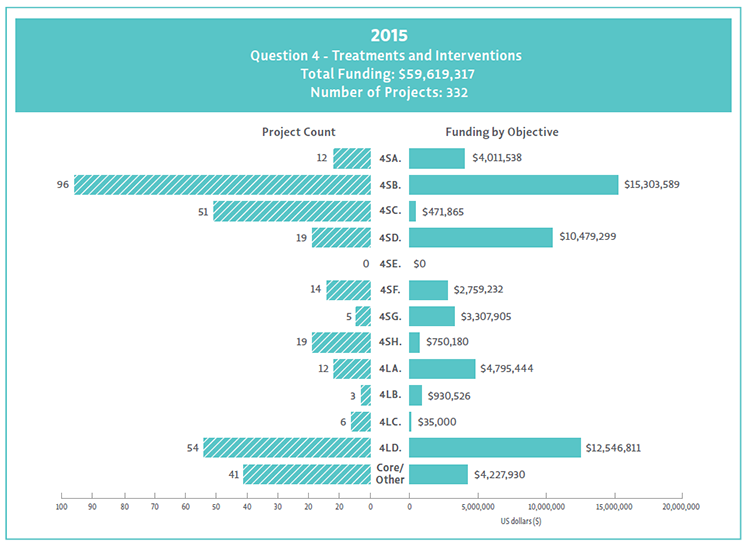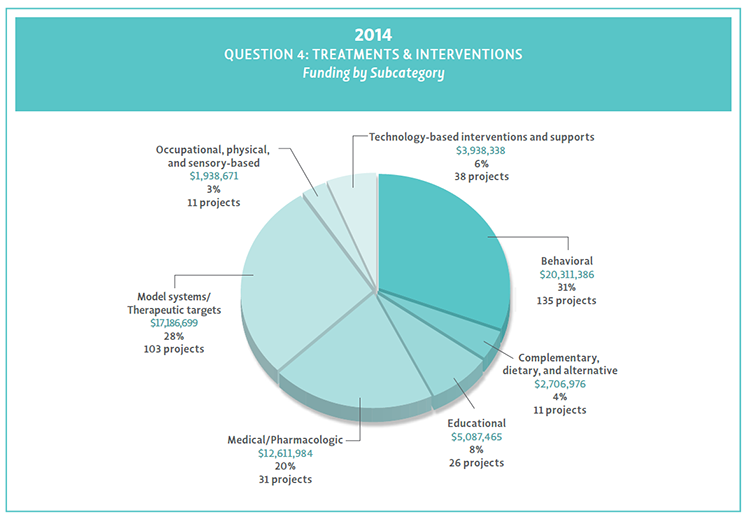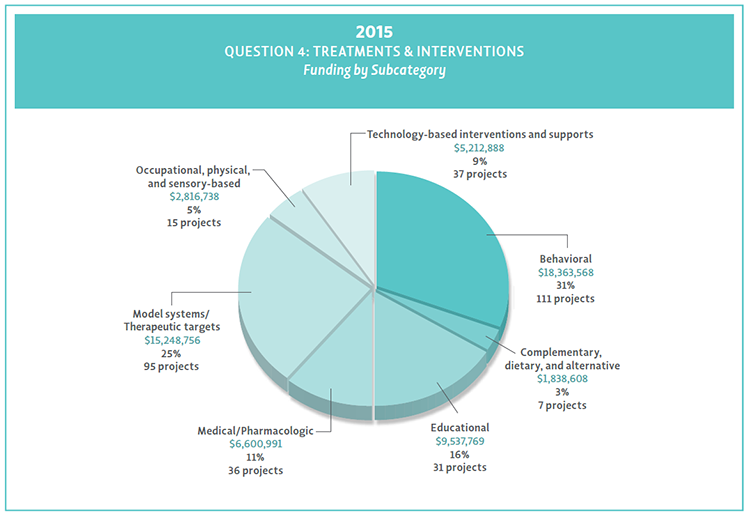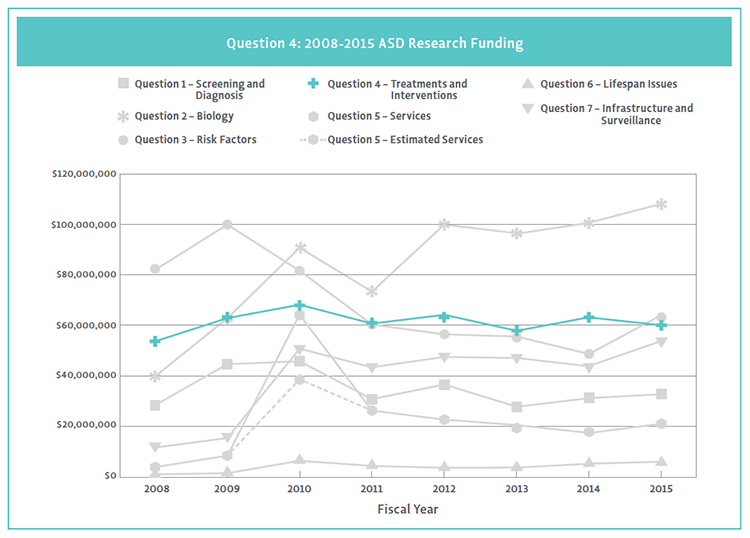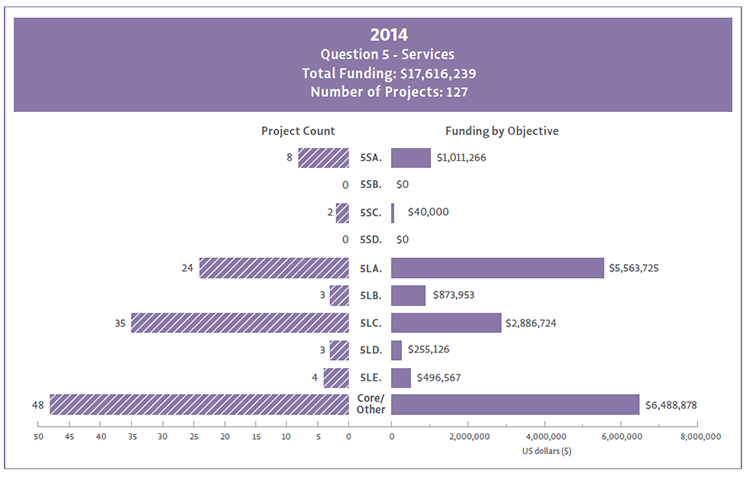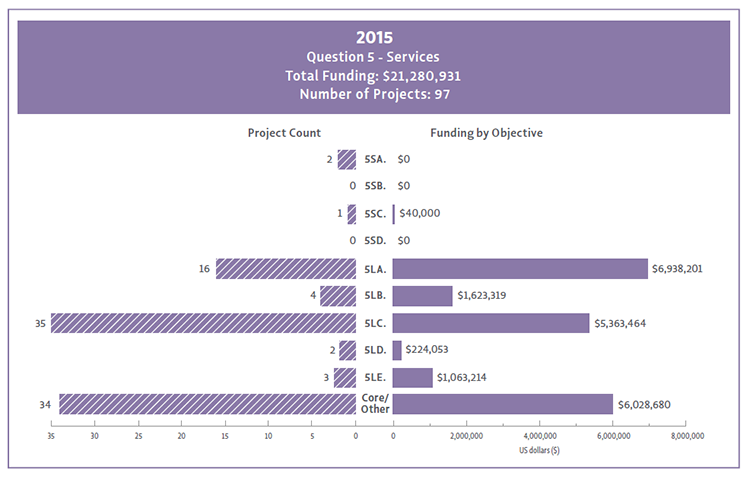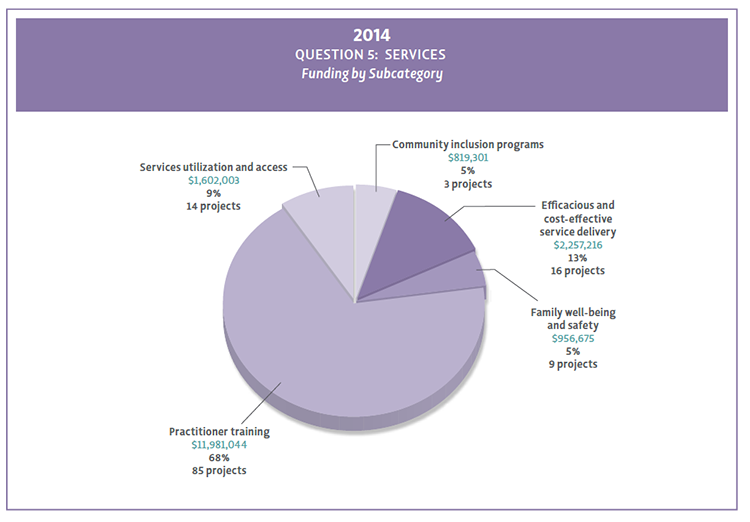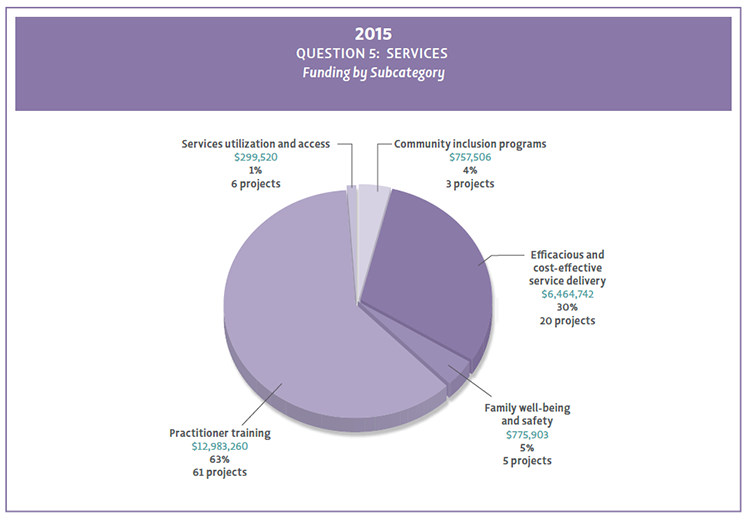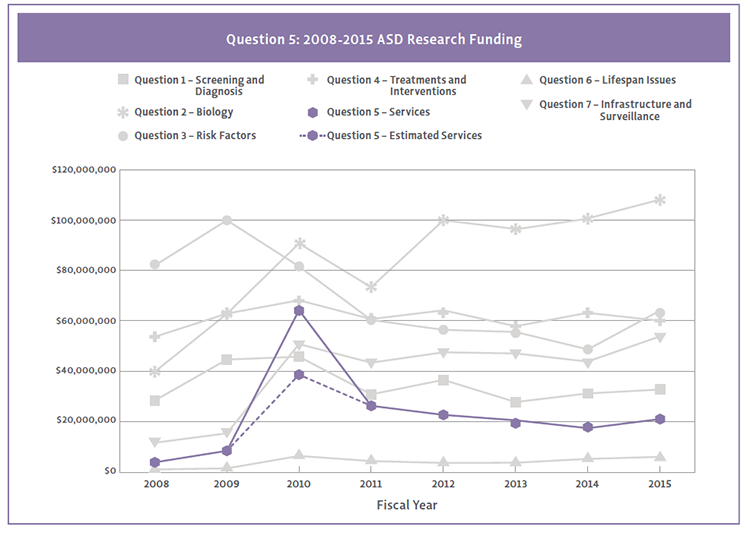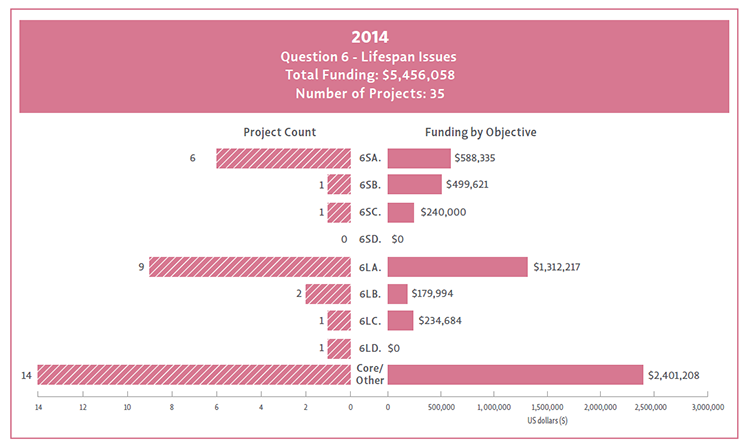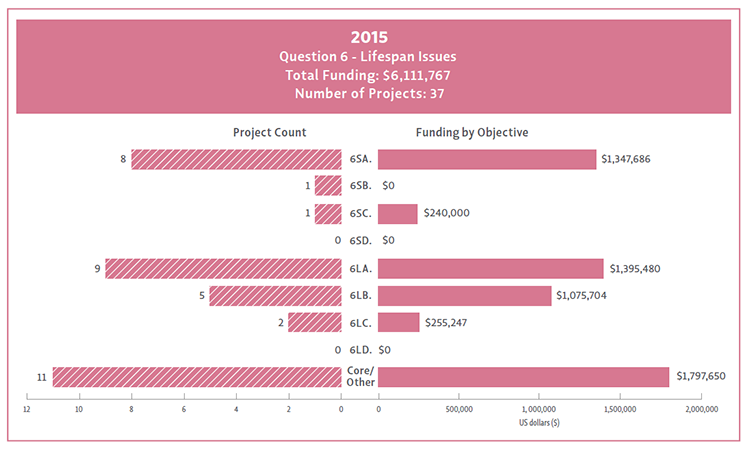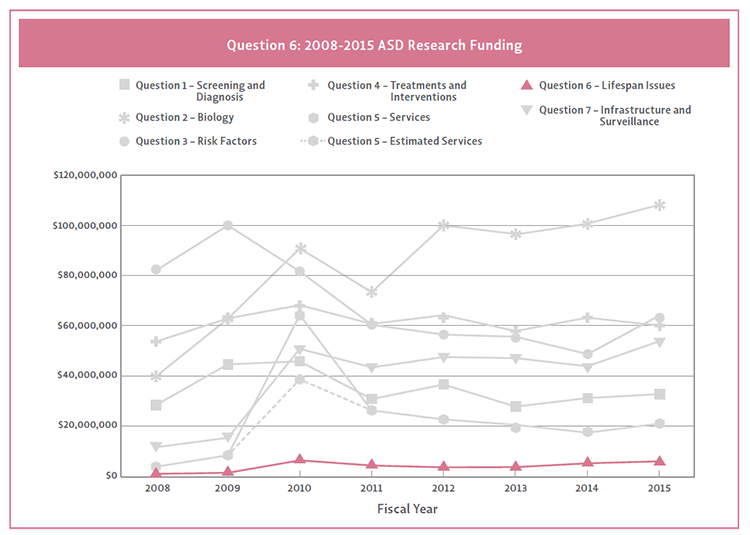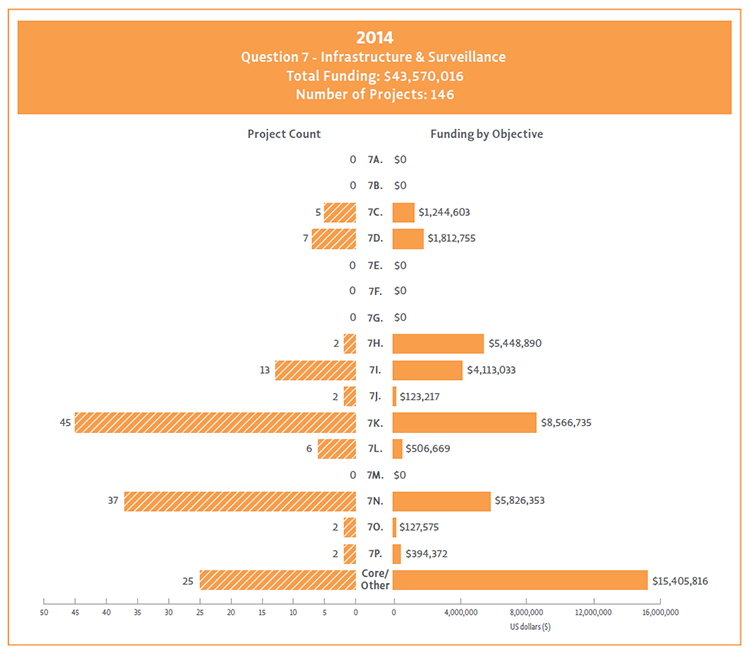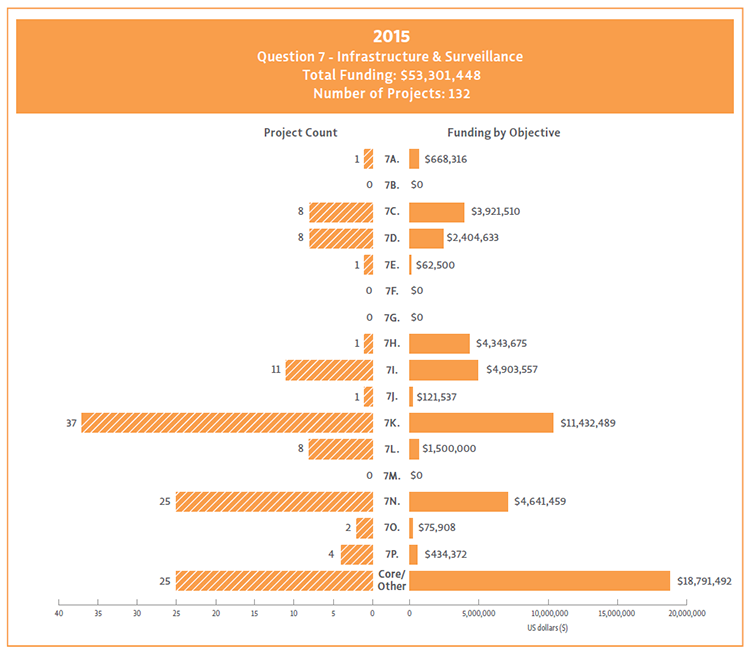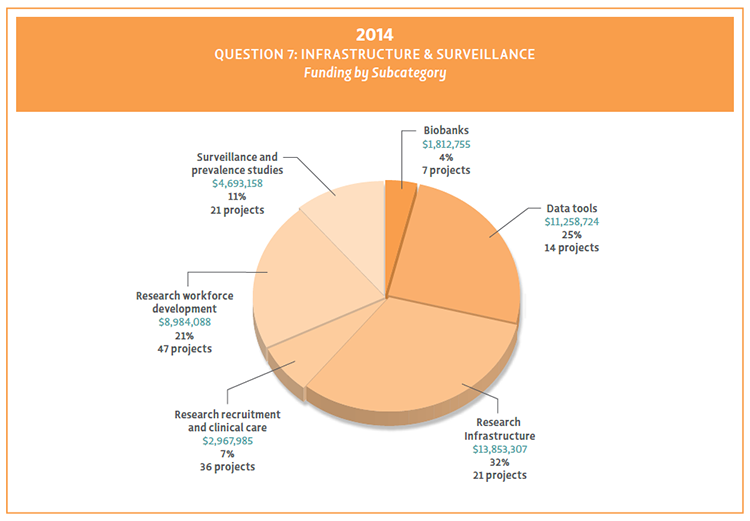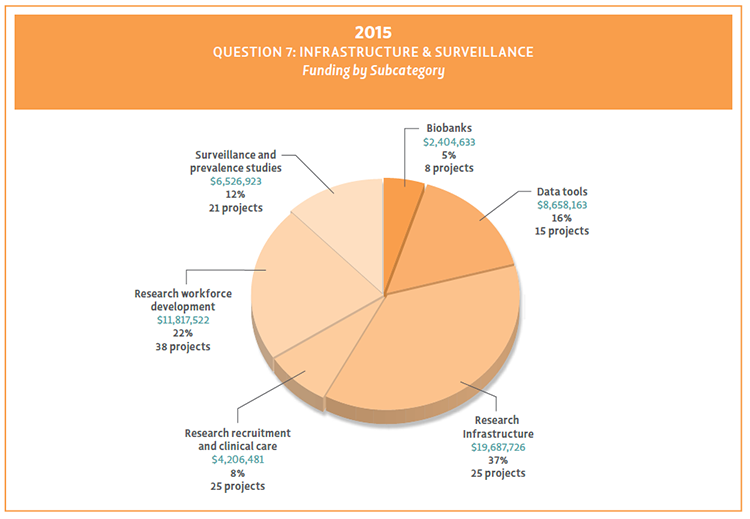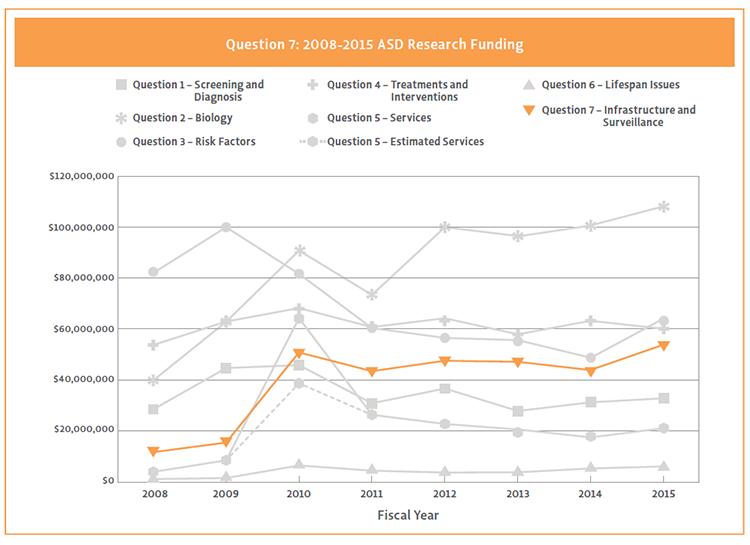Portfolio Analysis Report
IACC Autism Spectrum Disorder Research
2014-2015

Aspirational goal: Children at risk for ASD will be identified through reliable methods before ASD behavioral characteristics fully manifest.
Research Focus of Question 1
Question 1 of the IACC Strategic Plan (“When should I be concerned?”) pertains to the issues surrounding screening for and diagnosis of ASD, with a focus on early identification of children showing signs of ASD so that they have the opportunity to receive interventions and supports that will lead to improved outcomes. The objectives within this chapter of the Strategic Plan include research to develop biomarkers, screening tools, and diagnostic instruments to aid in early identification. Question 1 also includes research to better understand and overcome barriers to early identification, including efforts to increase access to health services, and to develop or adapt screening and diagnostic tools for use in a wide variety of community settings, at low cost, and in diverse populations. In addition, the Committee prioritized the need for screening and diagnostic tools for use in adolescents and adults, and for improved measures that can be used to assess intervention and service needs. Projects addressing issues related to adult screening and diagnosis may be captured either within Question 1 or Question 6 of the Strategic Plan (Question 6 focuses on issues relevant to transitioning youth and adults on the autism spectrum).
In an effort to describe the research funded in Question 1 in 2014 and 2015, a word cloud was generated using the project titles listed under this question (Figure 21). The size of each word within the word cloud indicates the frequency of its use in project titles. The word cloud visually portrays the main research themes and topics that were funded in Question 1.
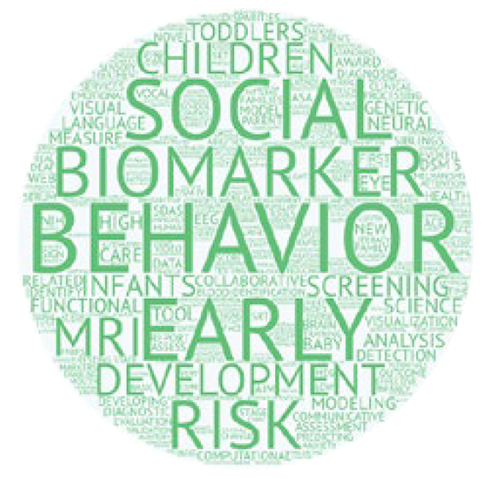
Figure 21. Word cloud representing themes in Question 1 project titles.
Analysis of 2014-2015 Question 1 Portfolio
When analyzing the distribution of research dollars across the seven question areas described in the IACC Strategic Plan, projects assigned to Question 1 comprised 10% ($31.0 million) of the total ASD research in 2014 and 9% (32.1 million) in 2015. The number of projects assigned to Question 1 totaled 117 projects (8% of all projects) in 2014 and 134 projects (10% of total projects) in 2015. The largest funders of research pertaining to Question 1 in 2014 are the National Institutes of Health, Simons Foundation, and Autism Speaks, whereas in 2015, the Health Resources and Services Administration became the third largest funder of research in Question 1. Progress made on Question 1 is measured through nine objectives. Figures 22 & 23 provide a detailed overview of each objective’s total funding in 2014 and 2015 as well as the number of projects assigned to each objective.
Figure 22. Question 1 objectives broken down by their funding and project count in 2014.
In 2014, six Question 1 objectives received funding, while two objectives did not have any funding or activity. As was the case in 2013, the Question 1 objective receiving the most funding in 2014 was 1.L.A, which focuses on identifying biomarkers for ASD; it received 30% ($9.1 million) of the Question 1 funding in 2014. This was followed by Objective 1.L.B, which supports the development of behavioral and biological measures for diagnosis and risk assessment, accounting for 19% ($5.9 million) of Question 1 overall funding. Objective 1.S.B. also received 19% ($5.8 million) of Question 1 funding; this objective focuses on improving the sensitivity and specificity of new and existing screening and diagnostic tools. Objective 1. L.B received the largest number of projects (35 projects), followed by Objective 1.L.A which had 31 projects. All other objectives received less than 20% of Question 1 funding in 2014, and only 3% of Question 1 funding went to projects categorized as Core/Other, which are projects not specific to Question 1 objectives. Studies to understand the impact of early diagnosis on choice of intervention and outcomes (1.S.D) received funding for the first time in 2014. Although Objective 1.S.F was also not funded in 2014, it was already considered completed due to workshops convened in previous years.
Figure 23. Question 1 objectives broken down by their funding and project count in 2015.
In 2015, seven Question 1 objectives had funding and two objectives had no funding or activity. The Question 1 objective receiving the most funding in 2015 was 1.L.B, which supports the development of behavioral and biological measures for diagnosis and risk assessment; it received 31% ($10.0 million) of the Question 1 funding. This was followed by Objective 1.L.A, which focuses on identifying biomarkers for ASD, accounting for 20% ($6.3 million) of Question 1 overall funding. Only 2% of Question 1 funding went to projects categorized as Core/Other. Again, Objective 1.S.F did not receive any funding in 2015, however it was already considered completed due to workshops convened in previous years. Table 5 lists all the objectives and their progress to date.
Question 1 Subcategory Analysis
With the development of the subcategory categorization scheme for the IACC ASD Research Portfolio Analysis, all projects can be categorized into broad research-related topic areas or themes, including projects that did not fit within the specific research objectives laid out in the Strategic Plan. This enables a more comprehensive understanding of the distribution of all projects across the general research areas aligning with Question 1. Overall, projects in Question 1 were divided into four subcategories: Diagnostic and screening tools; Early signs and biomarkers; Intermediate phenotypes/Subgroups; and Symptomology (Figures 24 & 25).
Of the four subcategories related to Question 1 (Screening and Diagnosis), in 2014 and 2015 the largest proportion of funding was devoted to the development of Diagnostic and screening tools for ASD (45% in 2014; 41% in 2015). Identifying Early signs and biomarkers was the second largest research investment in Question 1 (32% in 2014; 31% in 2015). Included in this subcategory were biological indicators (including genetic, metabolic, and brain structure/ connectivity) and behavioral biomarkers that can be used for screening/diagnosis or to measure progress or treatment response. This was followed by research characterizing Symptomology (14% in 2014; 15% in 2015). The subcategory receiving the lowest proportion of funding included research on identifying/ characterizing Intermediate phenotypes/Subgroups of people with ASD (9% in 2014; 13% in 2015).
Figure 24. Question 1 funding by subcategory in 2014.
Figure 25. Question 1 funding by subcategory in 2015.
Progress Made on Question 1 from 2008-2015
Figure 26 shows the trend in Question 1 funding over time. When considering annual funding for Question 1 from 2008-2015, portfolio analysis data showed that funding levels stayed relatively flat since 2008, with the exception of 2009 and 2010, during which federal funding for autism research was increased due to the American Recovery and Reinvestment Act.
Figure 26. Question 1 ASD research funding from 2008-2015. Funding for Question 1 was moderate and stayed relatively flat over the eight-year span.
Progress made on Question 1 Objectives from 2008-2015
After eight years of funding, six of the nine Question 1 objectives were considered completed in terms of the recommended amount of total funding invested. Of the remaining Question 1 objectives, partial progress was made on three, and no objectives were considered inactive (Figure 27). Objective 1.S.D received funding for the first time in 2014, changing the status from inactive to partially completed. Since 2013, two objectives reached their recommended funding budget. Table 5 provides an overview of progress made on all nine of the research objectives within Question 1 over the period from 2008-2015.
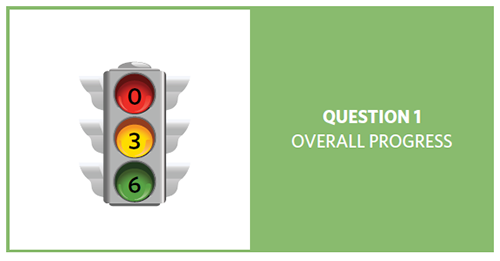
Figure 27. Overall status of progress for the nine Question 1 objectives.
Question 1: When Should I Be Concerned?
IACC Strategic Plan Objectives
| Year | 2008 | 2009 | 2010 | 2011 | 2012 | 2013 | 2014 | 2015 | Total |
|---|---|---|---|---|---|---|---|---|---|
|
Develop, with existing tools, at least one efficient diagnostic instrument (i.e., briefer, less time intensive) that is valid in diverse populations for use in large-scale studies by 2011. IACC Recommended Budget: $5,300,000 over 2 years |
|||||||||
Funding 20081.1 |
Funding 20091.1 |
Funding 20101.S.A |
Funding 20111.S.A |
Funding 20121.S.A |
Funding 20131.S.A |
Funding 20141.S.A |
Funding 20151.S.A |
Funding Total
|
|
|
Validate and improve the sensitivity and specificity of new or existing screening and diagnostic tools, including comparative studies of general developmental screening versus autism-specific screening tools, in both high-risk and population-based samples, including those from resource-poor international settings and those that are diverse in terms of age, socio-economic status, race, ethnicity, gender, characteristics of ASD, and general level of functioning by 2012. IACC Recommended Budget: $5,400,000 over 3 years |
|||||||||
Funding 20081.2 |
Funding 20091.S.B |
Funding 20101.S.B |
Funding 20111.S.B |
Funding 20121.S.B |
Funding 20131.S.B |
Funding 20141.S.B |
Funding 20151.S.B |
Funding Total
|
|
|
Conduct at least three studies to identify reasons for the health disparities in accessing early screening and diagnosis services, including identification of barriers to implementation of and access to screening, diagnosis, referral, and early intervention services among diverse populations, as defined by socioeconomic status, race, ethnicity, and gender of the child, by 2012. IACC Recommended Budget: $2,000,000 over 2 years |
|||||||||
Funding 2008N/A |
Funding 20091.S.C |
Funding 20101.S.C |
Funding 20111.S.C |
Funding 20121.S.C |
Funding 20131.S.C |
Funding 20141.S.C |
Funding 20151.S.C |
Funding Total
|
|
|
Conduct at least two studies to understand the impact of early diagnosis on choice of intervention and outcomes by 2015. IACC Recommended Budget: $6,000,000 over 5 years |
|||||||||
Funding 2008N/A |
Funding 20091.S.D |
Funding 20101.SD |
Funding 20111.S.D |
Funding 20121.S.D |
Funding 20131.S.D |
Funding 20141.S.D |
Funding 20151.S.D |
Funding Total
|
|
|
Conduct at least one study to determine the positive predictive value and clinical utility (e.g., prediction of co-occurring conditions, family planning) of chromosomal microarray genetic testing for detecting genetic diagnoses for ASD in a clinical setting by 2012. IACC Recommended Budget: $9,600,000 over 5 years |
|||||||||
Funding 2008N/A |
Funding 2009N/A |
Funding 20101.S.E |
Funding 20111.S.E |
Funding 20121.S.E |
Funding 20131.S.E |
Funding 20141.S.E |
Funding 20151.S.E |
Funding Total
|
|
|
Convene a workshop to examine the ethical, legal, and social implications of ASD research by 2011. The workshop should define possible approaches for conducting future studies of ethical, legal, and social implications of ASD research, taking into consideration how these types of issues have been approached in related medical conditions. IACC Recommended Budget: $35,000 over 1 year |
|||||||||
Funding 2008N/A |
Funding 2009N/A |
Funding 20101.S.F |
Funding 20111.S.F* |
Funding 20121.S.F* |
Funding 20131.S.F* |
Funding 20141.S.F* |
Funding 20151.S.F* |
Funding Total
|
|
|
Identify behavioral and biological markers that separately, or in combination, accurately identify, before age 2, one or more subtypes of children at risk for developing ASD, and evaluate whether these risk markers or profiles can improve early identification through heightened developmental monitoring and screening by 2014. IACC Recommended Budget: $33,300,000 over 5 years |
|||||||||
Funding 20081.3 |
Funding 20091.L.A |
Funding 20101.L.A |
Funding 20111.L.A |
Funding 20121.L.A |
Funding 20131.L.A |
Funding 20141.L.A |
Funding 20151.L.A |
Funding Total
|
|
|
Develop at least five measures of behavioral and/or biological heterogeneity in children or adults with ASD, beyond variation in intellectual disability, that clearly relate to etiology and risk, treatment response and/or outcome by 2015. IACC Recommended Budget: $71,100,000 over 5 years |
|||||||||
Funding 20081.4 |
Funding 20091.L.B |
Funding 20101.L.B |
Funding 20111.L.B |
Funding 20121.L.B |
Funding 20131.L.B |
Funding 20141.L.B |
Funding 20151.L.B |
Funding Total
|
|
|
Identify and develop measures to assess at least three "continuous dimensions" (i.e., social reciprocity, communication disorders, and repetitive/restrictive behaviors) of ASD symptoms and severity that can be used by practitioners and/or families to assess response to intervention for people with ASD across the lifespan by 2016. IACC Recommended Budget: $18,500,000 over 5 years |
|||||||||
Funding 20081.5 |
Funding 20091.L.C |
Funding 20101.L.C |
Funding 20111.L.C |
Funding 20121.L.C |
Funding 20131.L.C |
Funding 20131.L.C |
Funding 20131.L.C |
Funding Total
|
|
|
Not specific to any objective (Core/Other Activities) |
|||||||||
Funding 20081. Core/Other Activities |
Funding 20091. Core/Other Activities |
Funding 20101. Core/Other Activities |
Funding 20111. Core/Other Activities |
Funding 20121. Core/Other Activities |
Funding 20131. Core/Other Activities |
Funding 20141. Core/Other Activities |
Funding 20151. Core/Other Activities |
Funding Total
|
|
|
Total funding for Question 1 |
|||||||||
Funding 2008$29,123,209 |
Funding 2009$44,693,943 |
Funding 2010$45,622,080 |
Funding 2011$30,754,892 |
Funding 2012$36,856,119 |
Funding 2013$27,652,659 |
Funding 2014$30,966,274 |
Funding 2015$32,085,844 |
Funding Total$277,755,018 |
|
Question 1: Multiyear Funding Table, see Appendix C for a color-coding key and further details.
Table 5. Multiyear funding table for Question 1.

Aspirational goal: Discover how ASD affects development, which will lead to targeted and personalized interventions.
Research Focus of Question 2
Question 2 (“How can I understand what is happening?”) addresses the underlying biology of ASD. Research in this field focuses on identifying the biological differences and mechanisms in early development and throughout life that contribute to ASD, as well as the characterization of the behavioral and cognitive aspects of ASD. Projects range from basic neuroscience using cellular and animal models to clinical studies. Taken together, the aim of the research represented by Question 2 is to understand the biological processes underlying ASD from the molecular level to sensory, motor, behavioral, and cognitive development and functioning.
A word cloud was created using the project titles listed under Question 2 to provide a visual representation of the research funded in 2014 and 2015 (Figure 28). The size of each word within the word cloud indicates the frequency of its use in project titles. The word cloud visually depicts the main research themes and topics that were funded in Question 1.
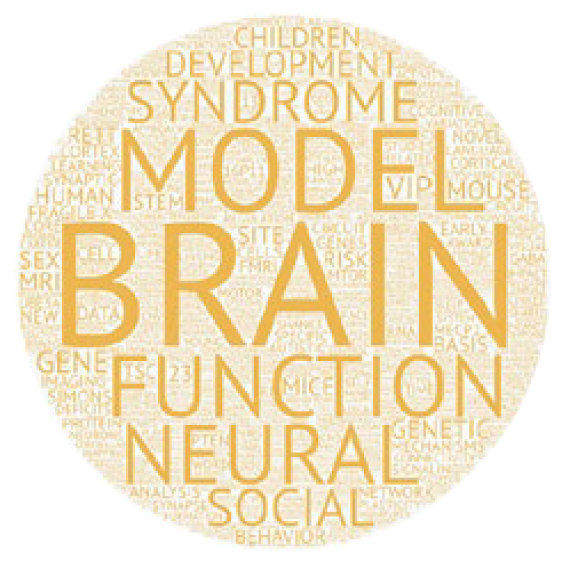
Figure 28. Word cloud representing themes in Question 2 project titles.
Analysis of 2014-2015 Question 2 Portfolio
Among the seven question areas described in the IACC Strategic Plan, Question 2 accounted for the largest portion of the ASD research portfolio in 2014 and 2015. Following similar trends as previous years, research in the biology of ASD (Question 2) comprised 32% of total funding in both years ($100.0 million in 2014; $107.7 million in 2015). Question 2 also had the largest portion of overall projects in 2014 (35%, 504 projects) and 2015 (34%, 481 projects). Among federal agencies and private organizations, the National Institutes of Health provided the largest investment, contributing 87% of Question 2 research funding in 2015. The Simons Foundation was the next major funder for Question 2. Research funding under Question 2 is categorized under nine objectives. Figures 29 & 30 provide a detailed overview of each objective’s total funding in 2014 and 2015 as well as the number of projects assigned to each objective.
All nine objectives in Question 2 experienced at least some progress in 2014. The majority of projects that were categorized under this question did not fit into any of the specific Question 2 research objectives and were assigned as Question 2 Core/Other ($47.9 million, 48%), similar to what was reported in previous years. Core/Other also accounted for nearly half of the project count towards Question 2 research. As is described in the previous section of this report, projects designated as Core/Other correspond to research areas that were already established and/or well-funded at the time the Strategic Plan was developed, as well as areas of emerging science that may not have been captured in the Strategic Plan objectives. The next largest portion of funding went to Objective 2.S.D ($20.4 million, 20%), which focuses on the underlying biology of genetic conditions related to ASD, such as Rett Syndrome and Fragile X Syndrome. Objective 2.S.G, which includes projects investigating a link between specific genotypes and functional or structural phenotypes, had the next greatest portion of funding ($13.2 million, 13%). Across portfolio analyses, Objectives 2.S.D and 2.S.G. have received the largest portion of Question 2 funding consistently since 2009.
Eight of the Question 2 objectives had active funding in 2015. Question 2 objectives followed similar funding patterns in 2015 as in prior years. The majority of Question 2 research funding was assigned to Core/ Other ($52.9 million, 49%) as well as majority of the project count (215 projects). The next largest portions of funding continued to be Objective 2.S.D ($18.6 million, 17%), followed by Objective 2.S.G ($13.6 million, 13%). Table 6 lists all the objectives and their progress to date.
Figure 29. Question 2 objectives broken down by their funding and project count in 2014.
Figure 30. Question 2 objectives broken down by their funding and project count in 2015.
Question 2 Subcategory Analysis
Due to the large proportion of research in Question 2 that could not be assigned to a particular objective, the subcategory analysis was particularly useful in understanding the distribution of research on the underlying mechanisms of ASD. Research in this area covers a broad array of science, and therefore Question 2 was divided into several subcategories. These include: Cognitive studies; Computational science; Co-occurring conditions; Developmental trajectory; Immune/Metabolic pathways; Molecular pathways; Neural systems; Neuropathology; Sensory and motor function; and Subgroups/Biosignatures (Figures 31 & 32).
As in previous years, the Question 2 subcategory with the largest portion of funding was Molecular pathways (33% in 2014; 36% in 2015), which includes systems of genes, proteins, and other molecules that are involved in ASD and related disorders. Research exploring the Neural systems was the second largest investment for both years (19% in 2014; 20% in 2015). The third largest subcategory focused on projects aiming to identify Subgroups/Biosignatures (14% in 2014; 10% in 2015). Research into the Developmental trajectory of ASD, including longitudinal studies that follow social, behavioral, and physical development over time accounted for 8% of Question 2 funding in 2014 and 7% of funding in 2015. Cognitive studies accounted for 8% of ASD funding in 2014, but had a slight drop to 4% of funding in 2015. Projects investigating Immune/ Metabolic pathways received 4% of research funding in 2014 and 5% of 2015 funding. Sensory and motor function accounted for 3% of funding in 2014 and 4% in 2015. Co-occurring conditions was 4% of Question 2 funding in 2014; this stayed relatively consistent at 5% of funding in 2015. Research in Computational science accounted for 3% of funding in 2014 and 2% of funding in 2015. Lastly, Neuropathology accounted for 4% of funding in 2014 and 7% of funding in 2015.
Figure 31. Question 2 funding by subcategory in 2014.
Figure 32. Question 2 funding by subcategory in 2015.
Progress Made on Question 2 From 2008-2015
Figure 33 shows the trend in Question 2 funding over time. Overall, funding for projects within Question 2 was higher than those of other question areas. When considering annual funding for Question 2 from 2008-2015, portfolio analysis data showed that funding levels for this question had only a moderate increase in recent years, despite having undergone a significant increase since 2008. Question 2 is the only question area that has been on a strongly upward funding trend over the period from 2008-2015. All other areas remained relatively flat or decreasing.
Figure 33. Question 2 ASD research funding from 2008-2015. Funding for Question 2 rapidly increased, and then leveled off, over the eight-year span.
Progress Made on Question 2 Objectives From 2008-2015
As of 2015, seven of the nine Question 2 objectives were considered completed in terms of meeting their overall budget recommendations, while two objectives were considered partially completed (Figure 34). The funding received for Question 2 Objective 2.S.B and 2.L.B in 2014 and 2015 was enough to change each objective’s overall status from partially completed as of 2013 to completed as of 2015. Table 6 provides a snapshot of progress made on all nine of the research objectives within Question 2 over the period from 2008-2015.
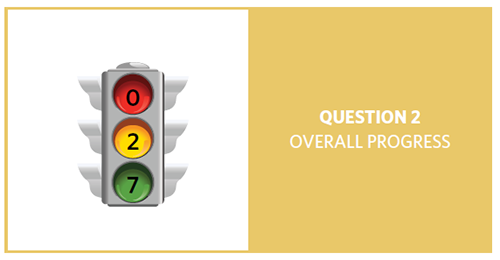
Figure 34. Overall status of progress for the nine Question 2 objectives.
Question 2: How Can I Understand What is Happening?
IACC Strategic Plan Objectives
| Year | 2008 | 2009 | 2010 | 2011 | 2012 | 2013 | 2014 | 2015 | Total |
|---|---|---|---|---|---|---|---|---|---|
|
Support at least four research projects to identify mechanisms of fever, metabolic and/or immune system interactions with the central nervous system that may influence ASD during prenatal-postnatal life by 2010 (Fever studies to be started by 2012). IACC Recommended Budget: $9,800,000 over 4 years |
|||||||||
Funding 20082.2 |
Funding 20092.S.A |
Funding 20102.S.A |
Funding 20112.S.A |
Funding 20122.S.A |
Funding 20132.S.A |
Funding 20142.S.A |
Funding 20152.S.A |
Funding Total
|
|
|
Launch three studies that specifically focus on the neurodevelopment of females with ASD, spanning basic to clinical research on sex differences by 2011. IACC Recommended Budget: $8,900,000 over 5 years |
|||||||||
Funding 20082.3 |
Funding 20092.S.B |
Funding 20102.S.B |
Funding 20112.S.B |
Funding 20122.S.B |
Funding 20132.S.B |
Funding 20142.S.B |
Funding 20152.S.B |
Funding Total
|
|
|
Identify ways to increase awareness among the autism spectrum community of the potential value of brain and tissue donation to further basic research by 2011. IACC Recommended Budget: $1,400,000 over 2 years |
|||||||||
Funding 20082.4 |
Funding 20092.S.C |
Funding 20102.S.C |
Funding 20112.S.C |
Funding 20122.S.C |
Funding 20132.S.C |
Funding 20142.S.C |
Funding 20152.S.C |
Funding Total
|
|
|
Launch three studies that target improved understanding of the underlying biological pathways of genetic conditions related to autism (e.g., Fragile X, Rett syndrome, tuberous sclerosis complex) and how these conditions inform risk assessment and individualized intervention by 2012. IACC Recommended Budget: $9,000,000 over 5 years |
|||||||||
Funding 2008N/A |
Funding 20092.S.D |
Funding 20102.S.D |
Funding 20112.S.D |
Funding 20122.S.D |
Funding 20132.S.D |
Funding 20142.S.D |
Funding 20152.S.D |
Funding Total
|
|
|
Launch three studies that target the underlying biological mechanisms of co-occurring conditions with autism, including seizures/epilepsy, sleep disorders, wandering/elopement behavior, and familial autoimmune disorders, by 2012. IACC Recommended Budget: $9,000,000 over 5 years |
|||||||||
Funding 2008N/A |
Funding 20092.S.E |
Funding 20102.S.E |
Funding 20112.S.E |
Funding 20122.S.E |
Funding 20132.S.E |
Funding 20142.S.E |
Funding 20152.S.E |
Funding Total
|
|
|
Launch two studies that focus on prospective characterization of children with reported regression to investigate potential risk factors by 2012. IACC Recommended Budget: $4,500,000 over 5 years |
|||||||||
Funding 2008N/A |
Funding 20092.S.F |
Funding 20102.S.F |
Funding 20112.S.F |
Funding 20122.S.F |
Funding 20132.S.F |
Funding 20142.S.F |
Funding 20152.S.F |
Funding Total
|
|
|
Support five studies that associate specific genotypes with functional or structural phenotypes, including behavioral and medical phenotypes (e.g., nonverbal individuals with ASD and those with cognitive impairments) by 2015. IACC Recommended Budget: $22,600,000 over 5 years |
|||||||||
Funding 2008N/A |
Funding 20092.S.G |
Funding 20102.S.G |
Funding 20112.S.G |
Funding 20122.S.G |
Funding 20132.S.G |
Funding 20142.S.G |
Funding 20152.S.G |
Funding Total
|
|
|
Complete a large-scale, multidisciplinary, collaborative project that longitudinally and comprehensively examines how the biological, clinical, and developmental profiles of individuals, with a special emphasis on females, youths, and adults with ASD, change over time as compared to typically developing people by 2020. IACC Recommended Budget: $126,200,000 over 12 years |
|||||||||
Funding 20082.5 |
Funding 20092.L.A |
Funding 20102.L.A |
Funding 20112.L.A |
Funding 20122.L.A |
Funding 20132.L.A |
Funding 20142.L.A |
Funding 20152.L.A |
Funding Total
|
|
|
Launch at least three studies that evaluate the applicability of ASD phenotype and/or biological signature findings for performing diagnosis, risk assessment, or clinical intervention by 2015. IACC Recommended Budget: $7,200,000 over 5 years |
|||||||||
Funding 2008N/A |
Funding 20092.L.B |
Funding 20102.L.B |
Funding 20112.L.B |
Funding 20122.L.B |
Funding 20132.L.B |
Funding 20132.L.B |
Funding 20132.L.B |
Funding Total
|
|
|
Not specific to any objective (Core/Other Activities) |
|||||||||
Funding 20082. Core/Other Activities |
Funding 20092. Core/Other Activities |
Funding 20102. Core/Other Activities |
Funding 20112. Core/Other Activities |
Funding 20122. Core/Other Activities |
Funding 20132. Core/Other Activities |
Funding 20142. Core/Other Activities |
Funding 20152. Core/Other Activities |
Funding Total
|
|
|
Total funding for Question 2† |
|||||||||
Funding 2008$40,621,403 |
Funding 2009$63,252,948 |
Funding 2010$91,260,349 |
Funding 2011$73,223,388 |
Funding 2012$100,254,414 |
Funding 2013$96,872,439 |
Funding 2014$100,029,453 |
Funding 2015$107,671,690 |
Funding Total$668,167,505* |
|
Question 2 Multiyear Funding Table, see appendix for a color-coding key and further detail.
*This total reflects all funding for projects aligned to current objectives in the 2011 IACC Strategic Plan and incorporates funding for projects that may have been coded differently in previous versions of the Plan.
†The totals reflect the funding and projects coded to this Question of the Strategic Plan in the particular year indicated at the top of the column. When reading each column vertically, please note that the projects and funding associated with each objective for 2008 may not add up to the total at the bottom of the column; this is due to revisions of the Strategic Plan that caused some objectives to be shifted to other Questions under the Plan. The projects and funding associated with these reclassified objectives are now reflected under the Question in which they appear in the 2011 Strategic Plan.
Table 6. Multiyear funding table for Question 2.

Aspirational goal: Causes of ASD will be discovered that inform prognosis and treatments and lead to prevention/preemption of the challenges and disabilities of ASD.
Research Focus of Question 3
Question 3 (“What caused this to happen and can it be prevented?”) focuses on the risk factors associated with the development of ASD. Research related to Question 3 looks at the role of genetics, epigenetics, and the environment in the development of ASD, as well as the interactions between risk factors. Question 3 objectives address topics such as the need to develop improved approaches to study environmental exposures and gene-environment interactions, and to explore the potential roles of the microbiome and epigenetics on etiology. Also included are studies of risk factors and protective factors (factors that may protect an individual from developing ASD, even in the presence of other risk factors).
To describe the research funded in Question 3 in 2014 and 2015, a word cloud was generated using the project titles listed under this question (Figure 35). The size of each word within the word cloud indicates the frequency of its use in project titles. The word cloud visually portrays the main research themes and topics that were funded in Question 3.
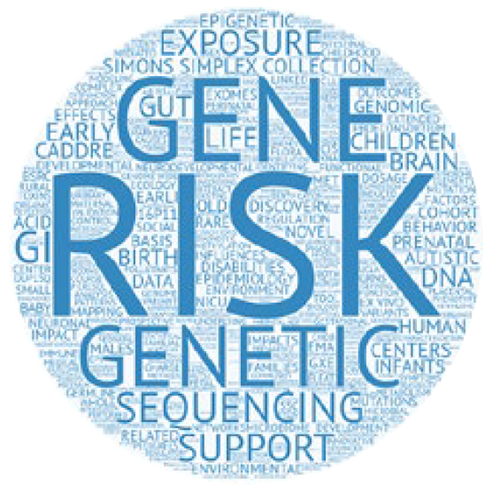
Figure 35. Word cloud representing themes in Question 3 project titles.
Analysis of 2014-2015 Question 3 Portfolio
In 2014, research on risk factors associated with ASD (Question 3) accounted for $48.5 million (16%) of total ASD research funding. In 2015, Question 3 funding increased to $62.6 million and accounted for 18% of overall ASD funding. The number of projects assigned to Question 3 totaled 157 projects (11% of all projects) in 2014 and 197 projects (14% of total projects) in 2015. The largest funders of Question 3 are the National Institutes of Health, Simons Foundation, and Centers for Disease Control and Prevention. Question 3 consists of 15 objectives. Figures 36 & 37 provide a detailed overview of each objective’s total funding in 2014 and 2015 as well as the number of projects assigned to each objective.
Figure 36. Question 3 objectives broken down by their funding and project count.
In 2014, thirteen of the fifteen objectives experienced at least some level of activity (one of the inactive objectives was completed in a previous year). Objective 3.L.B received the largest proportion of funding, which identifies genetic risk factors for ASD ($11.4 million; 24% of Question 3 funding). This was followed by Objective 3.L.D, which supports multiple sites within a large-scale study that collects data on environmental factors before and during pregnancy to assess any potential risk factors ($10.8 million, 22%). Objective 3.L.B had the largest number of projects (49 projects), followed by 3.S.J with 24 projects. All other objectives in Question 3 received a smaller portion of funding and number of projects. Though objective 3.S.G did not receive any new funding in 2014, it was completed by a workshop convened by the National Institute of Environmental Health Sciences (NIEHS) in 2011; objective 3.L.A did not receive funding in 2014.
Figure 37. Question 3 objectives broken down by their funding and project count in 2015.
In 2015, the majority of the objectives maintained funding activity. Only two objectives did not experience any funding or projects – one objective continuing to be the objective (3.S.G), which was completed in a previous year. Funding for objectives followed similar patterns to 2014; Objective 3.L.B received the largest portion of funding with $22.5 million and 36% of Question 3 funding. This was followed by Objective 3.L.D with $10.2 million and 16% of funding. When comparing project counts, 3.L.B continued to have the largest number of projects (60 projects). This was followed by Objective 3.S.H with 25 projects. Table 7 lists all the objectives and their progress to date.
Question 3 Subcategory Analysis
Projects in Question 3 were divided into four subcategories to determine the funding distribution across the research areas relating to understanding and identifying risk factors for ASD. These subcategories include: Environmental risk factors; Epigenetics; Gene-Environment studies; and Genetic risk factors (Figures 38 & 39).
In 2014 and 2015, studies focused on Genetic risk factors accounted for the highest percentage of Question 3 funding (38% in 2014; 50% in 2015). This is a change from 2013, when gene-environment research led Question 3 funding. Instead, investigating the role of environmental risk factors, genetic susceptibility, and/or the context of human physiology (Gene-Environment) was the second largest research investment in 2014 and 2015 (35% in 2014; 29% in 2015). Projects considering only Environmental risk factors received 16% of Question 3 funding in 2014 and 13% in 2015. Projects on Epigenetics received 11% of funding in 2014 and 8% in 2015, which included studies investigating DNA modifications and exploring altered gene expression due to environmental influences.
Figure 38. Question 3 funding by subcategory in 2014.
Figure 39. Question 3 funding by subcategory in 2015.
Progress made on Question 3 from 2008-2015
Figure 40 shows the trend in Question 3 funding over time. While research on risk factors remained supported at high levels over the eight-year period compared to some of the other question areas, the overall trend showed an initial increase followed by a rapid decrease and then a general leveling off of the annual funding level from 2011-2015.
Figure 40. Question 3 ASD research funding from 2008-2015. Funding for Question 3 initially showed an increase followed by a steady decrease, and then leveled off, over the eight-year span.
Progress Made on Question 3 Objectives From 2008-2015
As of 2015, eleven of Question 3’s objectives were considered completed, while the remaining four were partially complete based on the total recommended budget levels (Figure 41). Of the eleven completed objectives, two changed from an overall partially completed status as of 2013 to a completed status as of 2015. The objectives that have been newly completed as of 2015 include: 3.S.K, which supports research on model systems that explore environment interactions with genetic susceptibilities; and 3.S.A, which coordinates the inclusion of subjects for genome-wide association studies as well as the study of candidate genes through sequencing studies. Table 7 provides a snapshot of progress made on all 15 of the research objectives within Question 3 over the period from 2008-2015.
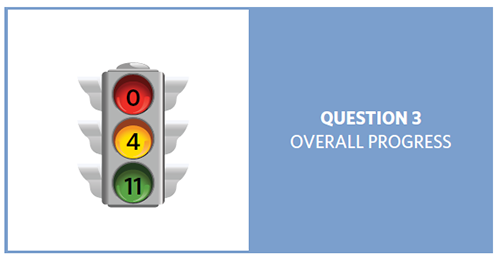
Figure 41. Overall status of progress for the 15 Question 3 objectives.
Question 3: What Caused This To Happen And Can It Be Prevented?
IACC Strategic Plan Objectives
| Year | 2008 | 2009 | 2010 | 2011 | 2012 | 2013 | 2014 | 2015 | Total |
|---|---|---|---|---|---|---|---|---|---|
|
Coordinate and implement the inclusion of approximately 20,000 subjects for genome-wide association studies, as well as a sample of 1,200 for sequencing studies to examine more than 50 candidate genes by 2011. Studies should investigate factors contributing to phenotypic variation across individuals who share an identified genetic variant and stratify subjects according to behavioral, cognitive, and clinical features. IACC Recommended Budget: $43,700,000 over 4 years |
|||||||||
Funding 20083.2 |
Funding 20093.S.A |
Funding 20103.S.A |
Funding 20113.S.A |
Funding 20123.S.A |
Funding 20133.S.A |
Funding 20143.S.A |
Funding 20153.S.A |
Funding Total
|
|
|
Within the highest-priority categories of exposures for ASD, identify and standardize at least three measures for identifying markers of environmental exposure in biospecimens by 2011. IACC Recommended Budget: $3,500,000 over 3 years |
|||||||||
Funding 20083.3 |
Funding 20093.S.B |
Funding 20103.SB |
Funding 20113.S.B |
Funding 20123.S.B |
Funding 20133.S.B |
Funding 20143.S.B |
Funding 20153.S.B |
Funding Total
|
|
|
Initiate efforts to expand existing large case-control and other studies to enhance capabilities for targeted gene-environment research by 2011. IACC Recommended Budget: $27,800,000 over 5 years |
|||||||||
Funding 20083.4 |
Funding 20093.S.C |
Funding 20103.S.C |
Funding 20113.S.C |
Funding 20123.S.C |
Funding 20133.S.C |
Funding 20143.S.C |
Funding 20153.S.C |
Funding Total
|
|
|
Enhance existing case control studies to enroll racially and ethnically diverse populations affected by ASD by 2011. IACC Recommended Budget: $3,300,000 over 5 years |
|||||||||
Funding 20083.5 |
Funding 20093.S.D |
Funding 20103.S.D |
Funding 20113.S.D |
Funding 20123.S.D |
Funding 20133.S.D |
Funding 20143.S.D |
Funding 20153.S.D |
Funding Total
|
|
|
Support at least two studies to determine if there are subpopulations that are more susceptible to environmental exposures (e.g., immune challenges related to infections, vaccinations, or underlying autoimmune problems) by 2012. IACC Recommended Budget: $8,000,000 over 2 years |
|||||||||
Funding 2008N/A |
Funding 20093.S.E |
Funding 20103.S.E |
Funding 20113.S.E |
Funding 20123.S.E |
Funding 20133.S.E |
Funding 20133.S.E |
Funding 20133.S.E |
Funding Total
|
|
|
Initiate studies on at least 10 environmental factors identified in the recommendations from the 2007 IOM report “Autism and the Environment: Challenges and Opportunities for Research” as potential causes of ASD by 2012. IACC Recommended Budget: $56,000,000 over 2 years |
|||||||||
Funding 20083.1 |
Funding 20093.S.F |
Funding 20103.S.F |
Funding 20113.S.F |
Funding 20123.S.F |
Funding 20133.S.F |
Funding 20143.S.F |
Funding 20153.S.F |
Funding Total
|
|
|
Convene a workshop that explores the usefulness of bioinformatic approaches to identify environmental risks for ASD by 2011. IACC Recommended Budget: $35,000 over 1 year |
|||||||||
Funding 2008N/A |
Funding 2009N/A |
Funding 20103.S.G |
Funding 20113.S.G |
Funding 20123.S.G* |
Funding 20133.S.G* |
Funding 20143.S.G* |
Funding 20153.S.G* |
Funding Total
|
|
|
Support at least three studies of special populations or use existing databases to inform our understanding of environmental risk factors for ASD in pregnancy and the early postnatal period by 2012. Such studies could include:
Emphasis on environmental factors that influence prenatal and early postnatal development is particularly of high priority. Epidemiological studies should pay special attention to include racially and ethnically diverse populations. IACC Recommended Budget: $12,000,000 over 5 years |
|||||||||
Funding 2008N/A |
Funding 2009N/A |
Funding 20103.S.H |
Funding 20113.S.H |
Funding 20123.S.H |
Funding 20133.S.H |
Funding 20143.S.H |
Funding 20153.S.H |
Funding Total
|
|
|
Support at least two studies that examine potential differences in the microbiome of individuals with ASD versus comparison groups by 2012. IACC Recommended Budget: $1,000,000 over 2 years |
|||||||||
Funding 2008N/A |
Funding 2009N/A |
Funding 20103.S.I |
Funding 20113.S.I |
Funding 20123.S.I |
Funding 20133.S.I |
Funding 20143.S.I |
Funding 20153.S.I |
Funding Total
|
|
|
Support at least three studies that focus on the role of epigenetics in the etiology of ASD, including studies that include assays to measure DNA methylations and histone modifications and those exploring how exposures may act on maternal or paternal genomes via epigenetic mechanisms to alter gene expression, by 2012. IACC Recommended Budget: $20,000,000 over 5 years |
|||||||||
Funding 2008N/A |
Funding 2009N/A |
Funding 20103.S.J |
Funding 20113.S.J |
Funding 20123.S.J |
Funding 20133.S.J |
Funding 20143.S.J |
Funding 20153.S.J |
Funding Total
|
|
|
Support two studies and a workshop that facilitate the development of vertebrate and invertebrate model systems for the exploration of environmental risks and their interaction with gender and genetic susceptibilities for ASD by 2012. IACC Recommended Budget: $1,535,000 over 3 years |
|||||||||
Funding 2008N/A |
Funding 2009N/A |
Funding 20103.S.K |
Funding 20113.S.K |
Funding 20123.S.K |
Funding 20133.S.K |
Funding 20143.S.K |
Funding 20153.S.K |
Funding Total
|
|
|
Conduct a multi-site study of the subsequent pregnancies of 1,000 women with a child with ASD to assess the impact of environmental factors in a period most relevant to the progression of ASD by 2014. IACC Recommended Budget: $11,100,000 over 5 years |
|||||||||
Funding 20083.7 |
Funding 20093.L.A |
Funding 20103.L.A |
Funding 20113.L.A |
Funding 20123.L.A |
Funding 20133.L.A |
Funding 20143.L.A |
Funding 20153.L.A |
Funding Total
|
|
|
Identify genetic risk factors in at least 50% of people with ASD by 2014. IACC Recommended Budget: $33,900,000 over 6 years |
|||||||||
Funding 20083.8 |
Funding 20093.LB |
Funding 20103.L.B |
Funding 20113.L.B |
Funding 20123.L.B |
Funding 20133.L.B |
Funding 20143.L.B |
Funding 20153.L.B |
Funding Total
|
|
|
Determine the effect of at least five environmental factors on the risk for subtypes of ASD in the prenatal and early postnatal period of development by 2015. IACC Recommended Budget: $25,100,000 over 7 years |
|||||||||
Funding 20083.6 |
Funding 20093.L.C |
Funding 20103.L.C |
Funding 20113.LC |
Funding 20123.L.C |
Funding 20133.L.C |
Funding 20143.L.C |
Funding 20153.L.C |
Funding Total
|
|
|
Support ancillary studies within one or more large-scale, population-based surveillance and epidemiological studies, including United States populations, to collect data on environmental factors during preconception, and during prenatal and early postnatal development, as well as genetic data, that could be pooled (as needed) to analyze targets for potential gene/environment interactions by 2015. IACC Recommended Budget: $44,400,000 over 5 years |
|||||||||
Funding 20083.9 |
Funding 20093.L.D |
Funding 20103.L.D |
Funding 20113.L.D |
Funding 20123.L.D |
Funding 20133.L.D |
Funding 20143.L.D |
Funding 20153.L.D |
Funding Total
|
|
|
Not specific to any objective |
|||||||||
Funding 20083. Core/Other Activities |
Funding 20093. Core/Other Activities |
Funding 20103. Core/Other Activities |
Funding 20113. Core/Other Activities |
Funding 20123. Core/Other Activities |
Funding 20133. Core/Other Activities |
Funding 20143. Core/Other Activities |
Funding 20153. Core/Other Activities |
Funding Total
|
|
|
Total funding for Question 3 |
|||||||||
Funding 2008$82,846,620 |
Funding 2009$100,043,216 |
Funding 2010$81,231,647 |
Funding 2011$60,209,628 |
Funding 2012$56,487,026 |
Funding 2013$55,666,352 |
Funding 2014$48,454,350 |
Funding 2015$62,565,031 |
Funding Total$547,503,869 |
|
Question 3: Multiyear Funding Table, see Appendix C for a color-coding key and further details.
Table 7. Multiyear funding table for Question 3.

Aspirational goal: Interventions will be developed that are effective for reducing both core and associated symptoms, for building adaptive skills, and for maximizing quality of life and health for people with ASD.
Research Focus of Question 4
Question 4 asks “Which treatments and interventions will help?” and covers a range of intervention approaches currently being considered, including pharmacological, behavioral, educational, occupational, technology-based, and alternative/complementary/ integrative medicine approaches. Research in this field encompasses the development of new treatments using model systems and small-scale experiments as well as full-scale clinical trials. Question 4 also includes studies to assess the safety and effectiveness of treatments already in use in the community.
A word cloud was created to describe the research funded in Question 4 using the project titles listed under the question (Figure 42). The size of each word within the word cloud indicates the frequency of its use in project titles. The word cloud visually portrays the main research themes and topics that were funded in Question 4.
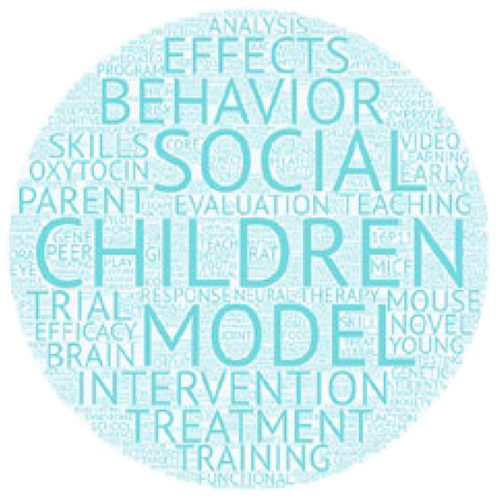
Figure 42. Word cloud representing themes in Question 4 project titles.
Analysis of 2014-2015 Question 4 Portfolio
Research focused on interventions and treatments (Question 4) received $63.8 million (20%) of total ASD funding in 2014 and 59.6 million (17%) of funding in 2015. The number of projects assigned to Question 4 totaled 355 projects in 2014, which was 25% of all projects included in the portfolio. In 2015, there were 332 projects assigned to Question 4, which accounted for 24% of all ASD projects. A large number of agencies and organizations invest in treatments and interventions; however, the three largest funders are the National Institutes of Health, Department of Education, and Simons Foundation. Question 4 has a total of 12 objectives focused on treatments and interventions. Figures 43 & 44 provide a detailed overview of each objective’s total funding in 2014 and 2015 as well as the number of projects assigned to each objective.
There was funding or projects associated with all twelve Question 4 objectives in 2014. As in previous years, the Question 4 objective receiving the most funding focuses on the development of model systems targeting areas for new interventions (4.S.B; $17.0 million, 27%), this objective also had the largest number of projects(102 projects). The second largest funded objective was Objective 4.S.D with $8.7 million (14%) and supports investments in randomized controlled trials for early intervention. Objective 4.L.D followed, which supports community-based studies assessing the effectiveness of interventions and services ($8.3 million; 13%). All other objectives received less funding in 2014, while a substantial portion (18%; $11.3 million) of Question 4 funding went to projects categorized as Core/Other (4.O).
Question 4 research funding in 2015 was similar to funding in 2014. Progress was made on all of the objectives except one (4.S.E). Objective 4.S.B continued to receive the largest investment of Question 4 funding ($15.3 million, 26%) and greatest number of projects (96 projects). The second largest funded objective was 4.L.D with $12.5 million in funding and making up 21% of the Question 4 portfolio. Objective 4.S.D followed with $10.5 million and 18% of funding. Table 8 lists all the objectives and their progress to date.
Figure 43. Question 4 objectives broken down by their funding and project count.
Figure 44. Question 4 objectives broken down by their funding and project count in 2015.
Question 4 Subcategory Analysis
Question 4 represents research on a wide array of different approaches to treatments and interventions for ASD, ranging from medications to alleviate core and co-occurring symptoms, to behavioral therapies and technologies to improve communication, socialization, life skills, and learning. Projects under Question 4 were broken down into these seven subcategories: Behavioral; Complementary, dietary, and alternative; Educational; Medical/Pharmacologic; Model systems/ Therapeutic targets; Occupational, physical, and sensory-based; and Technology-based interventions and supports (Figures 45 & 46).
The subcategories for Question 4 (Treatments and Interventions) illustrate the many approaches to treatments and interventions supported by autism research funders. In 2014 and 2015, the largest amount of funding supported projects to develop Behavioral interventions (31% for each year), including applied behavior analysis (ABA), cognitive therapy, and social skills training. Research on Model systems/Therapeutic targets (28% in 2014; 25% in 2015) followed, focusing on early development of animal and cellular models that mimic characteristics of ASD to test experimental therapies. Medical/Pharmacologic interventions received 20% of funding in 2014 and 11% in 2015. Educational (classroom-based) interventions received 8% of funding in 2014; this subcategory doubled in 2015, making up 16% in funding. Technology-based interventions and supports received 6% of funding in 2014 and 9% of funding in 2015. The subcategories with the smallest amounts of funding included Occupational, physical, and sensory-based (3% in 2014; 5% in 2015) and Complementary, dietary, and alternative interventions (4% in 2014; 3% in 2015).
Figure 45. Question 4 funding by subcategory in 2014.
Figure 46. Question 4 funding by subcategory in 2015.
Progress Made on Question 4 From 2008-2015
The trend in annual Question 4 funding over time is shown in Figure 47. Overall, research funding focused on treatments and interventions maintained a consistently moderate level over the eight-year time span. In the most recent years, Question 4 has had one of the largest proportions of funding compared to other Question areas.
Figure 47. Question 4 ASD research funding from 2008-2015. Funding for Question 4 remained primarily flat, but relatively robust, over the eight-year span.
Progress Made on Question 4 Objectives From 2008-2015
Based on the cumulative funding over eight years, six objectives were considered complete, while the remaining six objectives showed partial progress as of 2015 (Figure 48). Since 2013, two objectives moved from partial progress to meeting the objective’s recommended budget. Objective 4.L.A, which focuses on randomized controlled trials on medications targeting core symptoms of ASD, and Objective 4.L.D, which supports community-based studies assessing effective interventions, achieved completion of their recommended budgets. Table 8 provides a snapshot of progress made on all 12 of the research objectives within Question 4 over the period from 2008-2015.
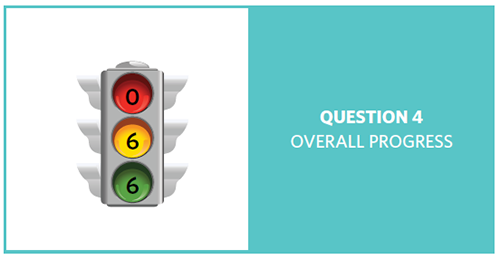
Figure 48. Overall status of progress for the 12 Question 4 objectives.
Question 4: Which Treatments And Interventions Will Help?
IACC Strategic Plan Objectives
| Year | 2008 | 2009 | 2010 | 2011 | 2012 | 2013 | 2014 | 2015 | Total |
|---|---|---|---|---|---|---|---|---|---|
|
Support at least three randomized controlled trials that address co-occurring medical conditions associated with ASD by 2010. IACC Recommended Budget: $13,400,000 over 3 years |
|||||||||
Funding 20084.2 |
Funding 20094.S.A |
Funding 20104.S.A |
Funding 20114.S.A |
Funding 20124.S.A |
Funding 20134.S.A |
Funding 20144.S.A |
Funding 20154.S.A |
Funding Total
|
|
|
Standardize and validate at least 20 model systems (e.g., cellular and/or animal) that replicate features of ASD and will allow identification of specific molecular targets or neural circuits amenable to existing or new interventions by 2012. IACC Recommended Budget: $75,000,000 over 5 years |
|||||||||
Funding 20084.5 |
Funding 20094.S.B |
Funding 20104.S.B |
Funding 20114.S.B |
Funding 20124.S.B |
Funding 20134.S.B |
Funding 20144.S.B |
Funding 20154.S.B |
Funding Total
|
|
|
Test safety and efficacy of at least five widely used interventions (e.g., nutrition, medications, assisted technologies, sensory integration, medical procedures) that have not been rigorously studied for use in ASD by 2012. IACC Recommended Budget: $27,800,000 over 5 years |
|||||||||
Funding 20084.6 |
Funding 20094.S.C |
Funding 20104.S.C |
Funding 20114.S.C |
Funding 20124.S.C |
Funding 20134.S.C |
Funding 20144.S.C |
Funding 20154.S.C |
Funding Total
|
|
|
Complete two multi-site randomized controlled trials of comprehensive early intervention that address core symptoms, family functioning and community involvement by 2013. IACC Recommended Budget: $16,700,000 over 5 years |
|||||||||
Funding 20084.7 |
Funding 20094.S.D |
Funding 20104.S.D |
Funding 20114.S.D |
Funding 20124.S.D |
Funding 20134.S.D |
Funding 20144.S.D |
Funding 20154.S.D |
Funding Total
|
|
|
Convene a workshop to advance the understanding of clinical subtypes and treatment personalization (i.e., what are the core symptoms to target for treatment studies) by 2011. IACC Recommended Budget: $50,000 *This objective was partially completed in 2011 |
|||||||||
Funding 2008N/A |
Funding 20094.S.E |
Funding 20104.S.E |
Funding 20114.S.E* |
Funding 20124.S.E* |
Funding 20134.S.E* |
Funding 20134.S.E* |
Funding 20154.S.E* |
Funding Total
|
|
|
Launch randomized controlled trials of interventions including biological signatures and other measures to predict response, and monitor quality of life and functional outcomes in each of the following groups:
|
|||||||||
Funding 20084.3 & 4.4 |
Funding 20094.S.F |
Funding 20104.S.F |
Funding 20114.S.F |
Funding 20124.S.F |
Funding 20134.S.F |
Funding 20144.S.F |
Funding 20154.S.F |
Funding Total
|
|
|
Support at least five studies on interventions for nonverbal individuals with ASD by 2012. Such studies may include:
IACC Recommended Budget: $3,000,000 over 2 years |
|||||||||
Funding 2008N/A |
Funding 2009N/A |
Funding 20104.S.G |
Funding 20114.S.G |
Funding 20124.S.G |
Funding 20134.S.G |
Funding 20144.S.G |
Funding 20154.S.G |
Funding Total
|
|
|
Support at least two studies that focus on research on health promotion and prevention of secondary conditions in people with ASD by 2012. Secondary conditions of interest include weight issues and obesity, injury, and co-occurring psychiatric and medical conditions. IACC Recommended Budget: $5,000,000 over 3 years |
|||||||||
Funding 2008N/A |
Funding 2009N/A |
Funding 20104.S.H |
Funding 20114.S.H |
Funding 20124.S.H |
Funding 20134.S.H |
Funding 20134.S.H |
Funding 20134.S.H |
Funding Total
|
|
|
Complete at least three randomized controlled trials on medications targeting core symptoms in people with ASD of all ages by 2014. IACC Recommended Budget: $22,200,000 over 5 years |
|||||||||
Funding 20084.8 |
Funding 20094.L.A |
Funding 20104.L.A |
Funding 20114.L.A |
Funding 20124.L.A |
Funding 20134.L.A |
Funding 20144.L.A |
Funding 20154.L.A |
Funding Total
|
|
|
Develop interventions for siblings of people with ASD with the goal of reducing the risk of recurrence by at least 30% by 2014. IACC Recommended Budget: $6,700,000 over 5 years |
|||||||||
Funding 20084.9 |
Funding 20094.L.B |
Funding 20104.L.B |
Funding 20114.L.B |
Funding 20124.L.B |
Funding 20134.L.B |
Funding 20144.L.B |
Funding 20154.L.B |
Funding Total
|
|
|
Conduct at least one study to evaluate the safety and effectiveness of medications commonly used in the treatment of co-occurring conditions or specific behavioral issues in people with ASD by 2015. IACC Recommended Budget: $10,000,000 over 5 years |
|||||||||
Funding 2008N/A |
Funding 20094.L.C |
Funding 20104.L.C |
Funding 20114.L.C |
Funding 20124.L.C |
Funding 20134.L.C |
Funding 20144.L.C |
Funding 20154.L.C |
Funding Total
|
|
|
Support at least five community-based studies that assess the effectiveness of interventions and services in broader community settings by 2015. Such studies may include comparative effectiveness research studies that assess the relative effectiveness of:
Outcome measures should include assessment of potential harm as a result of autism treatments, as well as positive outcomes. IACC Recommended Budget: $37,500,000 over 5 years |
|||||||||
Funding 2008N/A |
Funding 2009N/A |
Funding 20104.L.D. |
Funding 20114.L.D. |
Funding 20124.L.D. |
Funding 20134.L.D. |
Funding 20144.L.D. |
Funding 20154.L.D. |
Funding Total
|
|
|
Not specific to any objective (Core/Other Activities) |
|||||||||
Funding 20084. Core/Other Activities |
Funding 20094. Core/Other Activities |
Funding 20104. Core/Other Activities |
Funding 20114. Core/Other Activities |
Funding 20124. Core/Other Activities |
Funding 20134. Core/Other Activities |
Funding 20134. Core/Other Activities |
Funding 20134. Core/Other Activities |
Funding Total$65,810,798 |
|
|
Total funding for Question 4† |
|||||||||
Funding 2008$53,968,973 |
Funding 2009$63,403,016 |
Funding 2010$68,123,891 |
Funding 2011$60,819,121 |
Funding 2012$64,149,900 |
Funding 2013$58,065,840 |
Funding 2014$63,781,518 |
Funding 2015$59,619,317 |
Funding Total$489,545,304* |
|
Question 4 Multiyear Funding Table, see appendix C for a color-coding key and further details.
*This total reflects all funding for projects aligned to current objectives in the 2011 IACC Strategic Plan and incorporates funding for projects that may have been coded differently in previous versions of the Plan.
†The totals reflect the funding and projects coded to this Question of the Strategic Plan in the particular year indicated at the top of the column. When reading each column vertically, please note that the projects and funding associated with each objective for 2008 may not add up to the total at the bottom of the column; this is due to revisions of the Strategic Plan that caused some objectives to be shifted to other Questions under the Plan. The projects and funding associated with these reclassified objectives are now reflected under the Question in which they appear in the 2011 Strategic Plan.
Table 8. Multiyear funding table for Question 4.

Aspirational goal: Communities will access and implement necessary high-quality, evidence-based services and supports that maximize quality of life and health across the lifespan for all people with ASD
Research Focus of Question 5
Question 5 (“Where can I turn for services?”) focuses on services and supports for people with ASD. Objectives address issues including access to services for both individuals with ASD and their families, impact of self-directed care, coordination among State and local agencies’ community-based supports, and the assessment of the health, safety, and mortality of people with ASD. Question 5 also includes research to develop and evaluate training of service providers (pediatricians, teachers, social workers, etc.), and improve the efficacy, cost-effectiveness, and dissemination of evidence-based practices.
In an effort to provide a visual representation of the research funded in Question 5 in 2014 and 2015, a word cloud was generated using the project titles listed under this question (Figure 49). The size of each word within the word cloud indicates the frequency of its use in project titles. The word cloud visually portrays the main research themes and topics that were funded in Question 5.
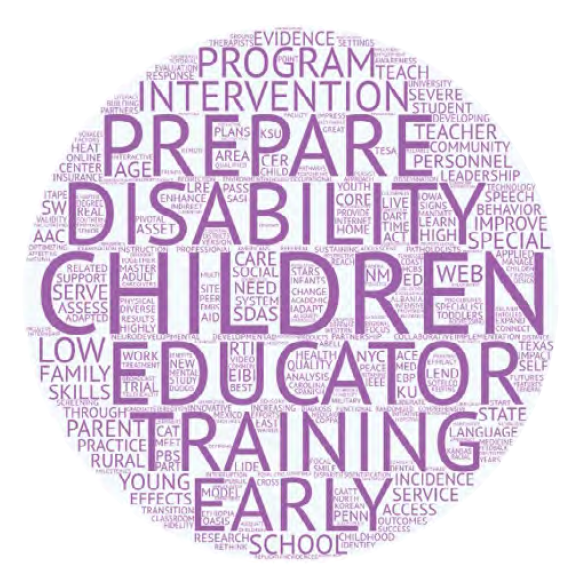
Figure 49. Word cloud representing themes in Question 5 project titles.
Analysis of 2014-2015 Question 5 Portfolio
Projects assigned to Question 5 comprised 6% of the total ASD research supported in 2014 ($17.6 million) and 2015 ($21.3 million). In 2014, Question 5 consisted of 127 projects, which was 9% of the total number of ASD projects. In 2015, Question 5 had 97 projects and accounted for 7% of the overall ASD project count. For both years, the largest funders of Question 5 are the Department of Education, National Institutes of Health, and Centers for Disease Control and Prevention. Question 5 contains nine objectives for tracking funding on ASD services research. Figures 50 & 51 provide a detailed overview of each objective’s total funding in 2014 and 2015 as well as the number of projects assigned to each objective.
Of the nine Question 5 objectives, seven Question 5 objectives had funding in 2014, and two objectives had no active projects or funding. The majority of projects that were categorized under this question did not fit into any of the specific Question 5 objectives and were assigned as Core/Other ($6.5 million, 37%). The next largest portion of funding went to 5.L.A, which supports projects improving dissemination, implementation, and sustainability of evidenced-based interventions ($5.6 million, 32%). Objective 5.L.C, research focused on the evaluation of new and existing training of service providers, followed with $2.9 million and 16% of Question 5 funding. Objectives 5.S.B and 5.S.D were not funded in 2014, but have received funding in previous years. Question 5 Core/Other had the largest number of projects (48 projects) while 5.L.C followed with 35 projects and 5.L.A had 24 projects. The rest of the objectives had significantly smaller project counts.
In 2015, the Question 5 objectives had comparable funding activities to previous years. Of the nine objectives in Question 5, seven objectives saw progress through funding or active projects. The largest portion of funding went to 5.L.A which accounted for $6.9 million and 33% of Question 5 funding. Funding towards research not specific to Question 5 objectives (Core/Other) had the second greatest portion of funding ($6 million; 28%). Objective 5.L.C followed with $5.4 million and 25% of Question 5 funding in 2015. Objective 5.S.A did not have any funding in 2015 but did have one active project. Objectives 5.S.B and 5.S.D were not funded in 2015, but have received funding in previous years. Objective 5.L.C had the largest number of projects (35 projects), followed by Question 5 Core/Other. Table 9 lists all the objectives and their progress to date.
Figure 50. Question 5 objectives broken down by their funding and project count in 2014.
Figure 51. Question 5 objectives broken down by their funding and project count in 2015.
Question 5 Subcategory Analysis
Projects within Question 5 have been categorized into five subcategories which reflect the general scope of research on services and supports: Community inclusion programs; Efficacious and cost-effective service delivery; Family well-being and safety; development and evaluation of Practitioner training; and Services utilization and access (Figures 52 & 53).
In 2014 and 2015, research falling under the development and evaluation of Practitioner training subcategory accounted for almost two-thirds (68% in 2014; 61% in 2015) of the funding for Question 5. Projects related to research on Efficacious and cost-effective service delivery, which covers research projects that assess current service delivery models as well as developing new and efficient ways of providing services, followed with 13% of the Question 5 funding in 2014 and 30% in 2015. Research focused on disparities and potential barriers to access are covered in Services utilization and access and accounted for 9% of funding in 2014; however this subcategory experienced a significant drop to 1% in 2015. Family well-being and safety research projects received 5% of funding in 2014 and 4% of funding in 2015. Projects relating to Community inclusion programs received 5% of Question 5 funding in 2014 and 4% in 2015.
Figure 52. Question 5 funding by subcategory in 2014.
Figure 53. Question 5 funding by subcategory in 2015.
Progress Made on Question 5 from 2008-2015
Figure 54 shows the trend in Question 5 funding over time using the adjusted funding total from Table 9. The adjusted funding reflects funding for projects aligned to objectives in the 2011 IACC Strategic Plan that may have been coded differently under previous versions of the plan. Research related to Question 5 was funded at relatively low levels when compared to other question areas. Funding for projects within Question 5 appeared to decrease slightly after 2010. As mentioned in the prior Portfolio Analysis reports, adjustments in reporting were made to only report autism-specific and research-related portions of larger projects within Question 5. A dotted line representing Question 5 funding in 2010 using the criteria that were applied in later years is included in the graph to enable a more accurate comparison among years. To calculate the estimated line for 2010, the same methodology for the prorated rates used in 2011 to 2015 was applied. (The projects that included practitioner training were prorated starting in 2011 to include only the portion of funding pertaining to development and evaluation of training, and not portions related to delivery of training). When these adjustments are made to the 2010 data set, the change from 2009 to 2010, and 2010 to 2011, appear to be less significant. Overall, when comparing 2008 funding for Question 5 with 2015 funding the general trend is upward.
Figure 54. Question 5 ASD research funding from 2008-2015. Compared to other Strategic Plan questions, funding for Question 5 remained relatively low over the eight-year span.
Progress Made On Question 5 Objectives From 2008-2015
An assessment of progress made on Question 5 objectives over the eight-year funding period shows that four objectives were considered completed as of 2015. All of the other five objectives have achieved partial progress toward their overall recommended budgeted goals since 2008 (Figure 55), despite the fact that two of these objectives did not see activity in 2015 specifically. Although many of the Question 5 objectives experienced growth in 2015, only one objective (5.L.E) moved from partial progress to being considered complete since 2013. Table 9 provides a snapshot of progress made on all nine of the research objectives within Question 5 over the period from 2008-2015.
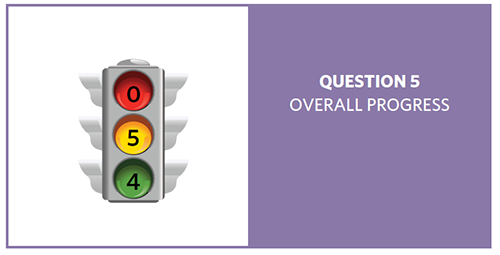
Figure 55. Overall status of progress for the nine Question 5 objectives.
Question 5: Where Can I Turn For Services?
IACC Strategic Plan Objectives
| Year | 2008 | 2009 | 2010 | 2011 | 2012 | 2013 | 2014 | 2015 | Total |
|---|---|---|---|---|---|---|---|---|---|
|
Support two studies that assess how variations in and access to services affect family functioning in diverse populations, including underserved populations, by 2012. IACC Recommended Budget: $1,000,000 over 3 years |
|||||||||
Funding 20085.2 |
Funding 20095.S.A |
Funding 20105.S.A |
Funding 20115.S.A |
Funding 20125.S.A |
Funding 20135.S.A |
Funding 20145.S.A |
Funding 20155.S.A |
Funding Total
|
|
|
Conduct one study to examine how self-directed community-based services and supports impact children, youth, and adults with ASD across the spectrum by 2014. IACC Recommended Budget: $6,000,000 over 3 years |
|||||||||
Funding 2008N/A |
Funding 20095.S.B |
Funding 20105.S.B |
Funding 20115.S.B |
Funding 20125.S.B |
Funding 20135.S.B |
Funding 20145.S.B |
Funding 20155.S.B |
Funding Total
|
|
|
Implement and evaluate five models of policy and practice-level coordination among State and local agencies to provide integrated and comprehensive community-based supports and services that enhance access to services and supports, self-determination, economic self-sufficiency, and quality of life for people with ASD across the spectrum and their families, (which may include access to augmentative and alternative communication [AAC] technology), with at least one project aimed at the needs of transitioning youth and at least one study to evaluate a model of policy and practice-level coordination among State and local mental health agencies serving people with ASD, by 2015. IACC Recommended Budget: $25,000,000 over 5 years |
|||||||||
Funding 2008N/A |
Funding 20095.S.C |
Funding 20105.S.C |
Funding 20115.S.C |
Funding 20125.S.C |
Funding 20135.S.C |
Funding 20145.S.C |
Funding 20155.S.C |
Funding Total
|
|
|
Support two studies to examine health, safety, and mortality issues for people with ASD by 2012. IACC Recommended Budget: $4,500,000 over 3 years |
|||||||||
Funding 2008N/A |
Funding 2009N/A |
Funding 20105.S.D |
Funding 20115.S.D |
Funding 20125.S.D |
Funding 20135.S.D |
Funding 20145.S.D |
Funding 20155.S.D |
Funding Total
|
|
|
Test four methods to improve dissemination, implementation, and sustainability of evidence-based interventions, services, and supports in diverse community settings by 2013. IACC Recommended Budget: $7,000,000 over 5 years |
|||||||||
Funding 20085.4 |
Funding 20095.L.A |
Funding 20105.L.A |
Funding 20115.L.A |
Funding 20125.L.A |
Funding 20135.L.A |
Funding 20145.L.A |
Funding 20155.L.A |
Funding Total
|
|
|
Test the efficacy and cost-effectiveness of at least four evidence-based services and supports for people with ASD across the spectrum and of all ages living in community settings by 2015. IACC Recommended Budget: $16,700,000 over 5 years |
|||||||||
Funding 20085.3 |
Funding 20095.L.B |
Funding 20105.L.B |
Funding 20115.L.B |
Funding 20125.L.B |
Funding 20135.L.B |
Funding 20145.L.B |
Funding 20155.L.B |
Funding Total
|
|
|
Evaluate new and existing pre-service and in-service training to increase skill levels in service providers, including direct support workers, parents and legal guardians, education staff, and public service workers, to benefit the spectrum of people with ASD and to promote interdisciplinary practice by 2015. IACC Recommended Budget: $8,000,000 over 5 years |
|||||||||
Funding 20086.3 |
Funding 20095.L.C |
Funding 20105.L.C |
Funding 20115.L.C |
Funding 20125.L.C |
Funding 20135.L.C |
Funding 20145.L.C |
Funding 20155.L.C |
Funding Total
|
|
|
Evaluate at least two strategies or programs to increase the health and safety of people with ASD that simultaneously consider principles of selfdetermination and personal autonomy by 2015. IACC Recommended Budget: $2,000,000 over 3 years |
|||||||||
Funding 2008N/A |
Funding 2009N/A |
Funding 20105.L.D |
Funding 20115.L.D |
Funding 20125.L.D |
Funding 20135.L.D |
Funding 20145.L.D |
Funding 20155.L.D |
Funding Total
|
|
|
Support three studies of dental health issues for people with ASD by 2015. This should include:
IACC Recommended Budget: $2,700,000 over 3 years |
|||||||||
Funding 2008N/A |
Funding 2009N/A |
Funding 20105.L.E |
Funding 20115.L.E |
Funding 20125.L.E |
Funding 20135.L.E |
Funding 20145.L.E |
Funding 20155.L.E |
Funding Total
|
|
|
Not specific to any objective (Core/Other Activities) |
|||||||||
Funding 20085. Core/Other Activities |
Funding 20095. Core/Other Activities |
Funding 20105. Core/Other Activities |
Funding 20115. Core/Other Activities |
Funding 20125. Core/Other Activities |
Funding 20135. Core/Other Activities |
Funding 20145. Core/Other Activities |
Funding 20155. Core/Other Activities |
Funding Total
|
|
|
Reported funding for Question 5* |
|||||||||
Funding 2008$1,685,222 |
Funding 2009$8,648,050 |
Funding 2010$64,849,122 |
Funding 2011$26,118,904 |
Funding 2012$22,827,101 |
Funding 2013$20,047,285 |
Funding 2014$17,616,239 |
Funding 2015$21,280,931 |
Funding Total$183,052,313 |
|
|
Adjusted funding for Question 5† |
|||||||||
Funding 2008$3,874,552 |
Funding 2009$8,648,051 |
Funding 2010$64,849,122 |
Funding 2011$26,118,904 |
Funding 2012$22,827,101 |
Funding 2013$20,047,285 |
Funding 2014$17,616,239 |
Funding 2015$21,280,931 |
Funding Total$185,241,644 |
|
Question 5 Multiyear Funding Table, see appendix for a color-coding key and further details.
*The “Reported funding” totals reflect the funding and projects coded to this Question of the Strategic Plan as reported in the Portfolio Analysis Report corresponding to the year indicated at the top of the column. When reading each column vertically, projects and funding may not add up to the reported funding total. The projects and funding associated with these reclassified objectives are now reflected under the Question in which they appear in the 2011 Strategic Plan.
†The “Adjusted funding” total reflects funding for projects aligned to objectives in the 2011 IACC Strategic Plan (the most recent version in which objectives were revised) and incorporates funding for projects that may have been coded differently under previous versions of the Plan.
Table 9. Multiyear funding table for Question 5.

Aspirational goal: All people with ASD will have the opportunity to lead self-determined lives in the community of their choice through school, work, community participation, meaningful relationships, and access to necessary and individualized services and supports.
Research Focus of Question 6
With increasing societal awareness of the needs of people on the autism spectrum across the lifespan, Question 6 addresses the question “What does the future hold, particularly for adults?” Question 6 encompasses research to identify and address issues surrounding transition to adulthood, access to services across the lifespan, and quality of life. Some of the research in Question 6 represents projects that assess the long-term outcomes (in terms of measures such as quality of life, health, independence, and employment) for people on the autism spectrum, particularly with respect to interventions and services they might have received. Many projects assigned to Question 6 focus on adolescents transitioning from the education system to employment, as well as vocational/job skills and social skills training for both transitional aged youth and adults.
In an effort to describe the research funded in Question 6 in 2014 and 2015, a word cloud was created using the project titles listed under this question (Figure 56). The size of each word within the word cloud indicates the frequency of its use in project titles. The word cloud visually portrays the main research themes and topics that were funded in Question 6.
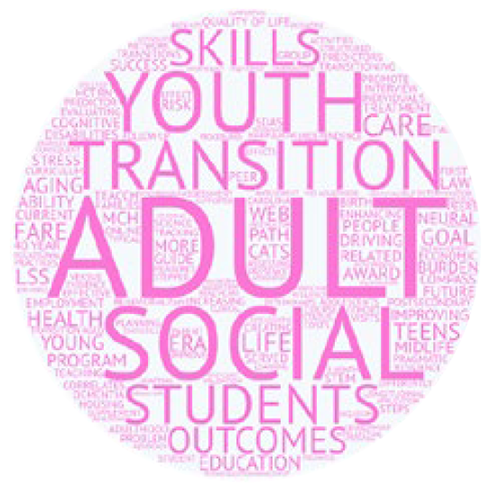
Figure 56. Word cloud representing themes in Question 6 project titles.
Analysis of 2014-2015 Question 6 Portfolio
In 2014, research on lifespan issues associated with ASD (Question 6) accounted for 2% ($5.5 million) of total ASD research funding and included 35 projects (2% of all projects). In 2015, Question 6 funding totaled $6.1 million (2% of funding) and maintained 37 projects (3% of all projects). This Question area has the smallest portion of funding and number of projects in both years. In 2014, the agencies and organizations with the largest stakes in this research are the National Institutes of Health, Department of Defense (Army), and Autism Speaks. In 2015, the National Institutes of Health and Department of Defense continued to lead funding in Question 6, but the Department of Education became the third largest funder. Question 6 consists of eight objectives. Figures 57 & 58 provide a detailed overview of each objective’s total funding as well as the number of projects assigned to each objective.
In 2014, six objectives received funding, and one objective included an active project with no funding. The largest portion of funding for this question went to projects that did not fit into any of the specific Question 6 research objectives and were assigned as Core/Other ($2.4 million, 44%). Objective 6.L.A followed in funding ($1.3 million; 24%), which focuses on developing community-based interventions that improve quality of life for adults with ASD. Also, Question 6 Core/ Other and Objective 6.L.A had the largest portions of projects; Core/Other had 14 projects and 6.L.A had 9 projects. The remaining objectives in Question 6 that received funding received significantly smaller portions of funding. Objectives 6.S.D did not receive funding but has been funded in previous years.
In 2015, five objectives received funding and one objective (6.S.B) included an active project with no funding. As in 2014, most projects that were categorized under this question did not fit into any of the specific Question 6 research objectives and were assigned as Core/Other ($1.8 million, 30%); this continued to be the largest number of projects as well (11 projects). Objective 6.L.A had the next largest portion in funding ($1.4 million; 23%); followed closely by Objective 6.S.A ($1.3 million; 22%), which supports studies assessing quality of life for adults with ASD and service delivery systems. Objectives 6.S.D and 6.L.D did not receive funding but have been funded in previous years. Table 10 lists all the objectives and their progress to date.
Figure 57. Question 6 objectives broken down by their funding and project count in 2014.
Figure 58. Question 6 objectives broken down by their funding and project count in 2015.
Question 6 Subcategory Analysis
Because Question 6 had so few assigned projects (35 in 2014; 37 in 2015) and because many projects encompassed more than one topic, it was difficult to formulate and group the research into subcategories in the same fashion as was done for the other questions. However, this will likely change as the research field concerned with ASD across the lifespan grows and matures, allowing the development of subcategories in the future.
Progress Made on Question 6 from 2008-2015
Figure 59 shows the trend in Question 6 funding over time using the adjusted funding total in Table 10. The adjusted funding reflects funding for projects aligned to objectives in the 2011 IACC Strategic Plan that may have been coded differently under previous versions of the plan. Research related to Question 6 received the lowest level of annual funding for every year of the eight-year time period. Although there was a small increase in funding for this question area from 2009-2010 and 2014-2015, the overall trend shows that funding for this question has stayed low and relatively flat over the eight-year period. The adjusted funding for 2008 and 2009 reflects funding for projects aligned to objectives in the 2011 IACC Strategic Plan and incorporates funding for projects that may have been coded differently under previous versions of the Plan. Based on the adjusted funding amounts, there was a slight increase in funding from 2008-2010.
Figure 59. Question 6 ASD research funding from 2008-2015. Funding for Question 6 remained low over the eight-year span but recently has experienced a slight increase.
Progress Made on Question 6 Objectives From 2008-2015
One Question 6 objective reached its recommended budget and seven objectives have been partially completed since 2008 (Figure 60). Since 2013, one objective made enough progress to change its overall status from partial progress to complete. Objective 6.L.B, which focuses on studies that assess the impact of childhood interventions and services on adult health and quality of life, reached its recommended budget. Table 10 provides a snapshot of progress made on all eight of the research objectives within Question 6 over the period from 2008-2015.
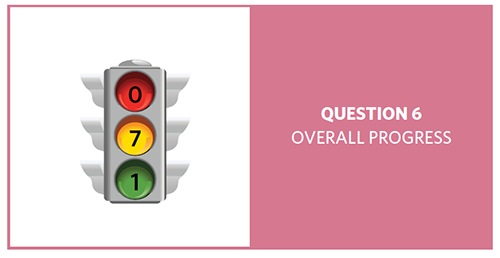
Figure 60. Overall status of progress for the eight Question 6 objectives.
Question 6: What Does The Future Hold, Particularly For Adults?
IACC Strategic Plan Objectives
| Year | 2008 | 2009 | 2010 | 2011 | 2012 | 2013 | 2014 | 2015 | Total |
|---|---|---|---|---|---|---|---|---|---|
|
Launch at least two studies to assess and characterize variation in the quality of life for adults on the ASD spectrum as it relates to characteristics of the service delivery system (e.g., safety, integrated employment, postsecondary educational opportunities, community inclusion, self-determination, relationships, and access to health services and community-based services) and determine best practices by 2012. IACC Recommended Budget: $5,000,000 over 3 years |
|||||||||
Funding 20086.2 |
Funding 20096.S.A |
Funding 20106.S.A |
Funding 20116.S.A |
Funding 20126.S.A |
Funding 20136.S.A |
Funding 20146.S.A |
Funding 20156.S.A |
Funding Total$4,973,763 |
|
|
Evaluate at least one model, at the State and local level, in which existing programs to assist people with disabilities (e.g., Social Security Administration, Rehabilitation Services Administration) meet the needs of transitioning youth and adults with ASD by 2013. IACC Recommended Budget: $5,000,000 over 3 years |
|||||||||
Funding 2008N/A |
Funding 20096.S.B |
Funding 20106.S.B |
Funding 20116.S.B |
Funding 20126.S.B |
Funding 20136.S.B |
Funding 20146.S.B |
Funding 20156.S.B |
Funding Total$2,599,621 |
|
|
Develop one method to identify adults across the ASD spectrum who may not be diagnosed, or are misdiagnosed, to support service linkage, better understand prevalence, and track outcomes with consideration of ethical issues (insurance, employment, stigma) by 2015. IACC Recommended Budget: $8,400,000 over 5 years |
|||||||||
Funding 2008N/A |
Funding 20096.S.C |
Funding 20106.S.C |
Funding 20116.S.C |
Funding 20126.S.C |
Funding 20136.S.C |
Funding 20146.S.C |
Funding 20156.S.C |
Funding Total$776,000 |
|
|
Conduct at least one study to measure and improve the quality of lifelong supports being delivered in community settings to adults across the spectrum with ASD through provision of specialized training for direct care staff, parents, and legal guardians, including assessment and development of ASD-specific training, if necessary, by 2015. IACC Recommended Budget: $7,500,000 over 5 years |
|||||||||
Funding 2008N/A |
Funding 20096.S.D |
Funding 20106.S.D |
Funding 20116.S.D |
Funding 20126.S.D |
Funding 20136.S.D |
Funding 20146.S.D |
Funding 20156.S.D |
Funding Total$619,163 |
|
|
Develop at least two individualized community-based interventions that improve quality-of-life or health outcomes for the spectrum of adults with ASD by 2015. IACC Recommended Budget: $12,900,000 over 5 years |
|||||||||
Funding 20086.5 |
Funding 20096.L.A |
Funding 20106.L.A |
Funding 20116.L.A |
Funding 20126.L.A |
Funding 20136.L.A |
Funding 20146.L.A |
Funding 20156.L.A |
Funding Total$8,563,202 |
|
|
Conduct one study that builds on carefully characterized cohorts of children and youth with ASD to determine how interventions, services, and supports delivered during childhood impact adult health and quality of life outcomes by 2015. IACC Recommended Budget: $5,000,000 over 5 years |
|||||||||
Funding 2008N/A |
Funding 20096.L.B |
Funding 20106.L.B |
Funding 20116.L.B |
Funding 20126.L.B |
Funding 20136.L.B |
Funding 20146.L.B |
Funding 20156.L.B |
Funding Total$5,596,591 |
|
|
Conduct comparative effectiveness research that includes a cost-effectiveness component to examine community-based interventions, services, and supports to improve health outcomes and quality of life for adults on the ASD spectrum over age 21 by 2018. Topics should include:
IACC Recommended Budget: $6,000,000 over 5 years |
|||||||||
Funding 2008N/A |
Funding 20096.L.C |
Funding 20106.L.C |
Funding 20116.L.C |
Funding 20126.L.C |
Funding 20136.L.C |
Funding 20146.L.C |
Funding 20156.L.C |
Funding Total$1,264,575 |
|
|
Conduct implementation research to test the results from comparative effectiveness research in real-world settings, including a cost-effectiveness component to improve health outcomes and quality of life for adults over 21 on the ASD spectrum by 2023. IACC Recommended Budget: $4,000,000 over 5 years |
|||||||||
Funding 2008N/A |
Funding 20096.L.D |
Funding 20106.L.D |
Funding 20116.L.D |
Funding 20126.L.D |
Funding 20136.L.D |
Funding 20146.L.D |
Funding 20156.L.D |
Funding Total$195,000 |
|
|
Not specific to any objective |
|||||||||
Funding 20086. Core/Other Activities |
Funding 20096. Core/Other Activities |
Funding 20106. Core/Other Activities |
Funding 20116. Core/Other Activities |
Funding 20126. Core/Other Activities |
Funding 20136. Core/Other Activities |
Funding 20146. Core/Other Activities |
Funding 20156. Core/Other Activities |
Funding Total$7,468,399 |
|
|
Reported funding for Question 6* |
|||||||||
Funding 2008$9,796,491 |
Funding 2009$1,407,699 |
Funding 2010$6,643,124 |
Funding 2011$4,897,920 |
Funding 2012$3,859,177 |
Funding 2013$3,152,885 |
Funding 2014$5,456,058 |
Funding 2015$6,111,767 |
Funding Total$41,325,121 |
|
|
Adjusted funding for Question 6† |
|||||||||
Funding 2008$527,683 |
Funding 2009$1,407,699 |
Funding 2010$6,643,124 |
Funding 2011$4,897,920 |
Funding 2012$3,859,177 |
Funding 2013$3,152,886 |
Funding 2014$5,456,058 |
Funding 2015$6,111,767 |
Funding Total$32,056,313 |
|
Question 6 Multiyear Funding Table, see appendix C for a color-coding key and further details.
*The “Reported funding” totals reflect the funding and projects originally coded to this Question of the Strategic Plan, as reported in the Portfolio Analysis Report corresponding to the year indicated at the top of the column. When reading each column of the table vertically, please note that the projects and funding associated with each objective for 2008 may not add up to the reported funding total at the bottom of the column; this is due to adjustments made to account for revisions in the Strategic Plan, which caused the shifting of some objectives to other Questions under the Plan. The projects and funding associated with these reclassified objectives are now reflected under the Question in which they appear in the 2011 Strategic Plan.
†The “Adjusted funding” total reflects funding for projects aligned to objectives in the 2011 IACC Strategic Plan (the most recent version in which objectives were revised) and incorporates funding for projects that may have been coded differently under previous versions of the Plan.
Table 10. Multiyear funding table for Question 6.

Aspirational goal: Develop and support infrastructure and surveillance systems that advance the speed, efficacy, and dissemination of ASD research.
Research Focus of Question 7
Question 7 (“What other infrastructure and surveillance needs must be met?”) covers the topics of research infrastructure, data sharing, workforce development, ASD surveillance, and communication/dissemination of research findings and evidence-based practices. With 16 objectives, Question 7 has the greatest number of objectives of all seven questions in the Strategic Plan.
A word cloud was made using the project titles listed under this question to describe the research funded in Question 7 in 2014 and 2015 (Figure 61). The size of each word within the word cloud indicates the frequen-cy of its use in project titles. The word cloud visually portrays the main research themes and topics that were funded in Question 7.
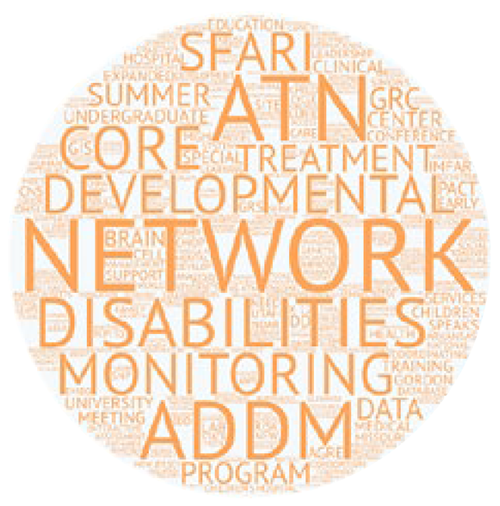
Figure 61. Word cloud representing themes in Question 7 project titles.
Analysis of 2014-2015 Question 7 Portfolio
Projects assigned to Question 7 comprised 14% ($43.6 million) of the total ASD research supported in 2014 and consisted of 145 projects, which was 10% of the total number of projects. In 2015, funding for Question 7 consisted of 16% ($53.3 million) of the overall ASD funding and totaled 131 projects (10% of all projects). In 2014 and 2015, the National Institutes of Health and Simons Foundation funded nearly three-quarters of research in Question 7. There are 16 objectives that fall under the Question 7 research area. Figures 62 & 63 provide a detailed overview of each objective’s total funding as well as the number of projects assigned to each objective.
In 2014, ten objectives received funding and six objectives did not have any active projects or funding. The largest portion of funding categorized under Question 7 did not fit into any of the specific research objectives and was assigned as Core/Other ($15.4 million, 35%). Of the 16 Question 7 objectives, programs enhancing the research workforce and developing interdisciplinary training (7.K) received the largest amount of funding ($8.6 million, 20%) and greatest portion of projects (45 projects). Objective 7.N followed with $5.8 million (13%) in funding and 37 projects; this objective funds the expansion of clinical research sites collecting and coordinating standardized and comprehensive diagnostic, biological, and medical data. Although Objective 7.G was not funded in 2014, it was already considered completed due to activity in previous years. Objective 7.E, which did not receive funding in 2014 to support the development of a virtual toolbox for researchers to disseminate findings, has received funding in previous years and is considered complete. Objectives 7.A, 7.B, 7.F, and 7.M also did not receive any funding in 2014. Objective 7.B has received funding in previous years and is considered partially completed. However, objectives 7.A, 7.F, and 7.M have never received funding, which may be due to the wording or specificity of the goal (e.g., the “Promising Practices” papers program mentioned in objective 7.M was piloted by Centers for Medicare & Medicaid prior to the launch of the Strategic Plan in 2009, but the program was not continued).
In 2015, the funding patterns were comparable to previous years. The majority of Question 7 funding went towards Core/Other ($18.8 million, 35%). The second largest funding amount went towards Objective 7.K, which supports enhancing the research workforce and developing interdisciplinary training ($11.4 million, 21%); it also had the largest number of projects (37 projects). Objective 7.I followed with $4.9 million (9%) in funding; this objective supports conducting analyses evaluating prevalence using existing ADDM Network sites. As in 2014, Objective 7.G did not receive funding in 2015, although it was already considered completed due to activity in previous years. Again, Objective 7.B did not receive funding but has received funding in previous years. After seven years of no funding activity, Objective 7.A, which assesses linking databases to track involvement of people with ASD in health, education, and social services, received funding for one project in 2015. However, 7.F, and 7.M continued to have no funding or activity through 2015. Table 11 lists all the objectives and their progress to date.
Figure 62. Question 7 objectives broken down by their funding and project count in 2014.
Figure 63. Question 7 objectives broken down by their funding and project count in 2015.
Question 7 Subcategory Analysis
The six subcategories in Question 7 reflect the broad array of ASD research infrastructure needs that have been identified by the IACC: Biobanks; Data tools; Research infrastructure; Research recruitment and clinical care; Research workforce development; and Surveillance and prevalence studies (Figures 64 & 65).
In Question 7, the subcategories encompass a diverse set of project types, with funding distributed relatively evenly across them. In 2014 and 2015, Research infrastructure received the largest portion of funding (32% in 2014; 37% in 2015). Data tools, such as National Database for Autism Research (NDAR) and the Autism Genetics Resource Exchange (AGRE), experienced an increase in funding and encompassed 25% ($11.3 million) of Question 7 funding in 2014; it continued to have a significant portion of funding in 2015 with 16% ($8.7 million) of funding. Research workforce development, which supports conferences and training for autism researchers, accounted for 21% ($9 million) of funding in 2014 and 22% ($11.8 million) of funding in 2015. Surveillance and prevalence studies, such as studies under the ADDM Network, had 11% of funding ($4.7 million) in 2014 and 12% ($6.5 million) in 2015. Research recruitment and clinical care, which helps increase participation in research studies and conduct medical evaluations of participants, received 7% ($3.0 million) in 2014 and 8% ($4.2 million) in 2015. Biobanks received the smallest portion of funding both years, 4% ($1.8 million) in 2014 and 5% ($2.4 million) in 2015.
Figure 64. Question 7 funding by subcategory in 2014.
Figure 65. Question 7 funding by subcategory in 2015.
Progress Made on Question 7 From 2008-2015
Figure 66 shows the trend in Question 7 funding over the eight-year span of 2008-2015 using the adjusted funding totals from Table 11. The adjusted funding reflects funding for projects aligned to objectives in the 2011 IACC Strategic Plan that may have been coded differently under previous versions of the plan. Research falling within this question area experienced a rapid increase in funding from 2008-2010. However, after 2010 funding levels for these infrastructure and surveillance projects leveled off to a flat, moderate level from 2010-2014. The year 2015 noticed a slight spike in funding for Question 7 research projects. The adjusted funding reflects funding for projects aligned to objectives in the 2011 IACC Strategic Plan and accounts for funding of projects that may have been coded differently under previous versions of the Plan.
Figure 66. Question 7 ASD research funding from 2008-2015. Following an initial increase from 2008-2010, funding for Question 7 remained primarily flat from 2010-2015.
Progress Made on Question 7 Objectives From 2008-2015
An assessment of total progress since 2008 indicates that ten Question 7 objectives were considered completed, four objectives saw partial progress toward their overall recommended budgeted goals, and two objectives – Objectives 7.F (replication studies) and 7.M (promising practices papers about successful services delivery strategies) – have experienced no progress as of 2015 (Figure 67). The Committee felt uncertain of whether the objective 7.F was feasible, and of whether or not 7.M had been replaced by other modes of dissemination. Objective 7.A (to support a needs assessment toward linkage of administrative databases) had not experienced any funding or activity in prior years, but the amount of funding it received in 2015 was enough for it to meet its recommended budget. Outside of Objective 7.A., the Question 7 objectives did not experience enough progress in funding to change the overall status of any of the objectives from what was reported in 2013. Table 11 provides a snapshot of progress made on all 16 of the research objectives within Question 7 over the period from 2008-2015.
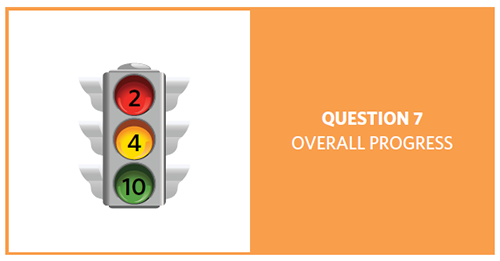
Figure 67. Overall status of progress for the 16 Question 7 objectives.
Question 7: What Other Infrastructure And Surveillance Must Be Met?
IACC Strategic Plan Objectives
| Year | 2008 | 2009 | 2010 | 2011 | 2012 | 2013 | 2014 | 2015 | Total |
|---|---|---|---|---|---|---|---|---|---|
|
Conduct a needs assessment to determine how to merge or link administrative and/or surveillance databases that allow for tracking the involvement of people living with ASD in health care, education, and social services by 2009. IACC Recommended Budget: $520,000 over 1 year |
|||||||||
Funding 20086.4 |
Funding 20097.A |
Funding 20107.A |
Funding 20117.A |
Funding 20127.A |
Funding 20137.A |
Funding 20147.A |
Funding 20157.A |
Funding Total$668,316 |
|
|
Conduct an annual “State of the States” assessment of existing State programs and supports for people and families living with ASD by 2011. IACC Recommended Budget: $300,000 each year |
|||||||||
Funding 20085.1 |
Funding 20097.B |
Funding 20107.B |
Funding 20117.B |
Funding 20127.B |
Funding 20137.B |
Funding 20147.B |
Funding 20157.B |
Funding Total$617,508 |
|
|
Develop and have available to the research community means by which to merge or link databases that allow for tracking the involvement of people in ASD research by 2010. IACC Recommended Budget: $1,300,000 over 2 years |
|||||||||
Funding 20086.1 |
Funding 20097.C |
Funding 20107.C |
Funding 20117.C |
Funding 20127.C |
Funding 20137.C |
Funding 20147.C |
Funding 20157.C |
Funding Total$19,934,513 |
|
|
Establish and maintain an international network of biobanks for the collection of brain tissue, fibroblasts for pluripotent stem cells, and other tissue or biological material, by acquisition sites that use standardized protocols for phenotyping, collection, and regulated distribution of limited samples by 2011.
IACC Recommended Budget: $82,700,000 over 5 years |
|||||||||
Funding 2008 |
Funding 20097.D |
Funding 20107.D |
Funding 20117.D |
Funding 20127.D |
Funding 20137.D |
Funding 20147.D |
Funding 20157.D |
Funding Total$32,339,220 |
|
|
Begin development of a web-based toolbox to assist researchers in effectively and responsibly disseminating their findings to the community, including people with ASD, their families, and health practitioners by 2011. IACC Recommended Budget: $400,000 over 2 years |
|||||||||
Funding 2008N/A |
Funding 20097.E |
Funding 20107.E |
Funding 20117.E |
Funding 20127.E |
Funding 20137.E |
Funding 20147.E |
Funding 20157.E |
Funding Total$1,316,650 |
|
|
Create funding mechanisms that encourage rapid replication studies of novel or critical findings by 2011. No recommended budget assigned by the IACC |
|||||||||
Funding 2008N/A |
Funding 20097.F |
Funding 20107.F |
Funding 20117.F |
Funding 20127.F |
Funding 20137.F |
Funding 20147.F |
Funding 20157.F |
Funding Total$0 |
|
|
Develop a web-based tool that provides population estimates of ASD prevalence for States based on the most recent prevalence range and average identified by the ADDM Network by 2012. (This objective can be considered completed – CDC’s Environmental Tracking tool) IACC Recommended Budget: $200,000 over 2 years *This objective was completed in 2012 |
|||||||||
Funding 2008N/A |
Funding 20097.G |
Funding 20107.G |
Funding 20117.G |
Funding 20127.G* |
Funding 20137.G* |
Funding 20147.G* |
Funding 20157.G* |
Funding Total$0 |
|
|
Create mechanisms to specifically support the contribution of data from 90% of newly initiated projects to the National Database for Autism Research (NDAR), and link NDAR with other existing data resources by 2012. IACC Recommended Budget: $6,800,000 over 2 years |
|||||||||
Funding 2008N/A |
Funding 20097.H |
Funding 20107.H |
Funding 20117.H |
Funding 20127.H |
Funding 20137.H |
Funding 20147.H |
Funding 20157.H |
Funding Total$20,402,397 |
|
|
Supplement existing ADDM Network sites to use population-based surveillance data to conduct at least five hypothesis-driven analyses evaluating factors that may contribute to changes in ASD prevalence by 2012. IACC Recommended Budget: $660,000 over 2 years |
|||||||||
Funding 2008N/A |
Funding 20097.I |
Funding 20107.I |
Funding 20117.I |
Funding 20127.I |
Funding 20137.I |
Funding 20147.I |
Funding 20157.I |
Funding Total$39,378,447 |
|
|
Develop the personnel and technical infrastructure to assist States, territories, and other countries that request assistance describing and investigating potential changes in the prevalence of ASD and other developmental disabilities by 2013. IACC Recommended Budget: $1,650,000 over 3 years |
|||||||||
Funding 2008N/A |
Funding 20097.J |
Funding 20107.J |
Funding 20117.J |
Funding 20127.J |
Funding 20137.J |
Funding 20147.J |
Funding 20157.J |
Funding Total$1,766,262 |
|
|
Encourage programs and funding mechanisms that expand the research workforce, enhance interdisciplinary research training, and recruit early-career scientists into the ASD field by 2013. IACC Recommended Budget: $5,000,000 over 3 years |
|||||||||
Funding 2008N/A |
Funding 20097.K |
Funding 20107.K |
Funding 20117.K |
Funding 20127.K |
Funding 20137.K |
Funding 20147.K |
Funding 20157.K |
Funding Total$54,262,321 |
|
|
Expand the number of ADDM sites in order to conduct ASD surveillance in children and adults; conduct complementary direct screening to inform completeness of ongoing surveillance; and expand efforts to include autism subtypes by 2015. IACC Recommended Budget: $16,200,000 over 5 years |
|||||||||
Funding 2008N/A |
Funding 20097.L |
Funding 20107.L |
Funding 20117.L |
Funding 20127.L |
Funding 20137.L |
Funding 20147.L |
Funding 20157.L |
Funding Total$9,039,827 |
|
|
Support 10 “Promising Practices” papers that describe innovative and successful services and supports being implemented in communities that benefit the full spectrum of people with ASD, which can be replicated in other communities, by 2015. IACC Recommended Budget: $75,000 over 5 years |
|||||||||
Funding 2008N/A |
Funding 20097.M |
Funding 20107.M |
Funding 20117.M |
Funding 20127.M |
Funding 20137.M |
Funding 20147.M |
Funding 20157.M |
Funding Total$0 |
|
|
Enhance networks of clinical research sites offering clinical care in real-world settings that can collect and coordinate standardized and comprehensive diagnostic, biological (e.g., DNA, plasma, fibroblasts, urine), medical, and treatment history data that would provide a platform for conducting comparative effectiveness research and clinical trials of novel autism treatments by 2012. IACC Recommended Budget: $1,850,000 over 1 year |
|||||||||
Funding 2008N/A |
Funding 2009N/A |
Funding 20107.N |
Funding 20117.N |
Funding 20127.N |
Funding 20137.N |
Funding 20147.N |
Funding 20157.N |
Funding Total$37,437,612 |
|
|
Create an information resource for ASD researchers (e.g., PhenX Project ) to share information to facilitate data sharing and standardization of methods across projects by 2013.
IACC Recommended Budget: $2,000,000 over 2 years |
|||||||||
Funding 2008N/A |
Funding 2009N/A |
Funding 20107.O |
Funding 20117.O |
Funding 20127.O |
Funding 20137.O |
Funding 20147.O |
Funding 20157.O |
Funding Total$3,335,762 |
|
|
Provide resources to centers or facilities that develop promising vertebrate and invertebrate model systems, and make these models more easily available or expand the utility of current model systems, and support new approaches to develop high-throughput screening technologies to evaluate the validity of model systems by 2013. IACC Recommended Budget: $1,100,000 over 2 years |
|||||||||
Funding 2008N/A |
Funding 2009N/A |
Funding 20107.P |
Funding 20117.P |
Funding 20127.P |
Funding 20137.P |
Funding 20147.P |
Funding 20157.P |
Funding Total$2,542,523 |
|
|
Not specific to any objective |
|||||||||
Funding 2008N/A |
Funding 20097. Core/Other Activities |
Funding 20107. Core/Other Activities |
Funding 20117. Core/Other Activities |
Funding 20127. Core/Other Activities |
Funding 20137. Core/Other Activities |
Funding 20147. Core/Other Activities |
Funding 20157. Core/Other Activities |
Funding Total$91,217,896 |
|
|
Reported funding for Question 7* |
|||||||||
Funding 2008N/A |
Funding 2009$15,809,755 |
Funding 2010$50,847,065 |
Funding 2011$43,855,291 |
Funding 2012$47,516,197 |
Funding 2013$43,022,248 |
Funding 2014$43,570,016 |
Funding 2015$53,301,448 |
Funding Total$302,161,197 |
|
|
Adjusted funding for Question 7† |
|||||||||
Funding 2008$12,098,057 |
Funding 2009$15,809,755 |
Funding 2010$50,847,065 |
Funding 2011$43,855,291 |
Funding 2012$47,516,197 |
Funding 2013$43,022,248 |
Funding 2014$43,570,016 |
Funding 2015$53,301,448 |
Funding Total$314,259,254 |
|
Question 7 Multiyear Funding Table, see appendix C for a color-coding key and further details.
*The “Reported funding” totals reflect the funding and projects originally coded to this Question of the Strategic Plan, as reported in the Portfolio Analysis Report corresponding to the year indicated at the top of the column. When reading each column of the table vertically, please note that the projects and funding associated with each objective for 2008 may not add up to the reported funding total at the bottom of the column; this is due to adjustments made to account for revisions in the Strategic Plan, which caused the shifting of some objectives to other Questions under the Plan. The projects and funding associated with these reclassified objectives are now reflected under the Question in which they appear in the 2011 Strategic Plan.
†The “Adjusted funding” total reflects funding for projects aligned to objectives in the 2011 IACC Strategic Plan (the most recent version in which objectives were revised) and incorporates funding for projects that may have been coded differently under previous versions of the Plan.
Table 11. Multiyear funding table for Question 7.


